#tapestry of sherlock bbc
Text
THE GOVERNOR AND HIS WIFE - revisited and expanded
________________________________________________________________

While writing on the ‘Tapestry of Sherlock BBC’ series, I picked up again my previous interpretations regarding the Five Tasks of Sherrinford. The attempt to summarize Eurus’ first task in some short sentences and linking it to the first series of the show, simply wouldn’t work out smoothly. Although I basically still agree with most of this first interpretation, the feeling was undeniable that something (isn’t there always something?) wouldn’t really fit. Therefore I started to mull over that problem in order to reach a more fitting conclusion. Apparently, the distance of several years resulted indeed in some new ideas and perspectives.

TBC below the cut .....
Sherlock BBC is dominated by a ‘pattern of five’, that has been noticed very early on by several people. To name just a view: Good things come in fives by tjlcisthenewsexy (now @debussy-reverie), A series of five by @thepineapplering , 5 Pips by @waitedforgarridebs and @sagestreet has connected the Five Tasks of Sherrinford with the four existing series of Sherlock BBC, along with the prospect of a possible fifth and final one. Which would be great and very much appreciated because the story, as it is now, feels quite open-ended. In any case, I couldn’t agree more with @sagestreet regarding the possible relation between five series and five tasks of Sherrinford (although I prefer a slightly different reading of some character mirrors).
As mentioned in previous posts, I tend to view the whole story told in Sherlock BBC on a metaphorical level, as something that happens entirely inside the great detective’s head. In TAB it is mentioned that Sherlock is able to create complex scenarios, even whole worlds, inside his mind palace. It seems only reasonable that he uses this extraordinary gift as a means to understand and solve his clients cases. That he uses the same methods when he tries to solve his very own case - the pink one - would then also be quite plausible. The investigations and deductions, necessary to explore his own persona, could very well happen on - what I like to call it - a mind stage. Like a director Sherlock writes the scripts for his plays and casts different characters for different roles to understand either the motives behind criminal cases, strange mysteries or the workings inside his own mind and body. In this old post I played with the idea of Sherlock BBC as a metaphhorical prism, created to make the different aspects of Sherlock’s personality visible, like rainbow colours occur when white light is sent through a prism. That actually ‘anyone’ inside this story is Sherlock, or more precisely, represents a certain part of him, is something @sherlockshadow suggested very early on.
The first task of Sherrinford
A possible interpretation based on metaphorical reading:

SHERRINFORD ISLAND - is a high-security government facility on a prison island and - the way I interpret the story - a metaphor for Sherlock’s innermost core. It represents the deepest part inside his mind, the place where he keeps everything under lock and key what he deems too dangerous or too painful to deal with. This high-security facility is under the supervision of the government, represented in this story by Lady Smallwood, Mycroft and the island’s Governor David (no family name given). It is mentioned that the mysterious Uncle Rudi had been the first one who took care of (his niece) Eurus and brought her to Sherrinford. Later Mycroft thought it best to continue what Uncle Rudi began. It might be of interest that the Hebrew name ‘David’ means ‘beloved’ or ‘uncle’.
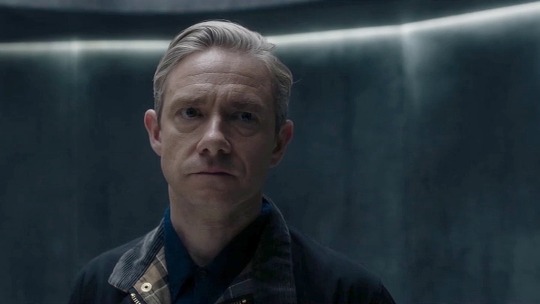
JOHN - he is the central part of the story, the crux of the matter, around whom everything else rotates. In the original story about the Musgrave Ritual one crown and two kings of the same name are involved. This might be another indication that not only cyphers come in pairs. I wrote about that topic in: Two times - John, Faith, Charles, pairs, therapists, John’s stamp. Either way, there are some indications that two versions of John are involved in this story:
Dr John Watson, the century old traditional eternal just-friend, the fixed point in a changing age, who constantly assures in this adaptation that he’s not gay. He represents Sherlock’s supressed and desperately unspoken love for his best friend, an unfulfilled desire that almost kills him.
John, a changed and new version of this character, openminded and vibrant, a man who is able and excited to become Sherlock’s lover. PILOT-John gives the impression to be ecaxtly the man whom Sherlock desires.
John in TFP seems to be on a good way to become that man ... not because the character per se has changed. Much more important is that Sherlock’s attitude towards the problem, that the John-character represents, has changed. John - on Sherlock’s mind stage, isn’t a ‘real’ person, like all the other characters he is an imagined ‘actor’ and represents a certain attitude (for lack of a better wording). More pecisely, if the theory of the ‘two Johns’ is correct, two possibilities can be associated with that character ... eternal friend and future lover. And it is Sherlock’s decision to see and to choose, which of the two attitudes he is willing to engage with in real life, outside his mind palace. Because if ‘real’ John is the man he seems to be in PILOT, it will certainly not be him who stands opposed to the ‘lover-attitude’. It will be solely Sherlock’s move to change his own literary history. Will he be bold enough to ‘get involved’ ... or not? One thing is certain, Sherlock has changed enormously from ASIP to TFP and has become a very good man by now. ‘Real-John’ could hardly get a better one ... :)

JIM - the virtual stationmaster and ticking clock of the experiments conducted in Sherrinford is called ‘Eurus’ revenge’ and represents, as he himself says in TRF ‘I’m Mr Sex’. The changeable criminal mastermind is also the one who hides in plain sight as ‘Hamish’ behind the ‘H’ of John’s middle name. When five years ago Eurus noticed Jim’s interest in Sherlock’s activities, Mycroft took a calculated risk and brought Jim to Sherrinford as a Christmas present for Eurus. It turned out that Jim and Eurus - sex and emotions - ‘got on like a house on fire’. And apparently this ‘five minutes conversation, five years ago’ had been THE trigger for everything that happend afterwards ... ‘It took her just five minutes to do all of this to us.’ The way I interpret the story, this can only be the moment when Sherlock laid first eyes on John Watson. Suddenly Mr Sex raises very intrigued his head and the long neglected, disparaged and locked-up Emotions react to that entirely unexpected situation and desire to know more about that ‘special condition’. As a consequence Emotions finally want to break free from their prison ... or, to put it in metaphorical words: “there’s going to be a terror strike on London (Sherlock) - a big one ...” (And suddenly everything changes The first time ever I saw your face)

Jim, Mr Sex, has been chosen by E, the ‘avenging sister, to be ‘her revenge’. With so much revenge and avenging on the table - associated with emotions and sex - inevitably the title screen of the Unaired Pilot comes to mind with Anteros (Eros’ brother) at centre stage. In Greek mythology Anteros is the god of requitted love, punisher of those who scorn love and the avenger of unrequitted love.
So he is in love, but he knows not with whom; he does not understand his own condition and cannot explain it; like one who has caught a disease of the eyes from another, he can give no reason for it; he sees himself in his lover as in a mirror, but is not conscious of the fact. And in the lover’s presence, like him he ceases from his pain, and in his absence, like him he is filled with yearning such as he inspires, and love’s image, requited love [Anteros], dwells within him; but he calls it, and believes it to be, not love, but friendship. (From Cupids: Eros, Anteros, and Greek Interpretations by @fandeadgloves)
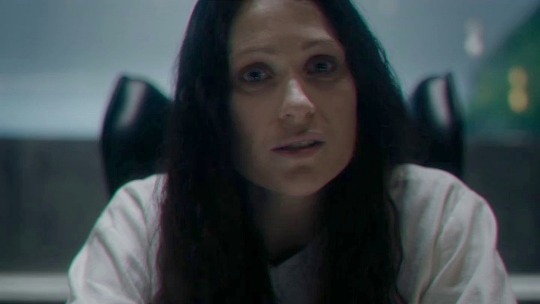
EURUS - she represents the ‘other one’. Sherlock’s supressed, neglected and almost forgotten emotional other side - locked-up deep down at his innermost core and under the strict surveillance of the government, the brain. I’m going by the assumption that all the criminal gangs, all the terrorist groups as well as TABs 'invisible army, the monstrous regiment’ - established and led by the avenging ghost-bride and faithful sister Emelia - ‘ignored, patronised, disregarded, not allowed so much as a vote’ - that all those opponents actually represent Sherlock’s revolting emotions. In TFP this ‘league of furies’ seems to have been compressed into one single character - Eurus - of which two versions (they always come in pairs) appear in this episode:

The adult woman and high-security prisoner who is incarcerated deep down in Sherrinford, surrounded by an ocean of water, until she breaks free and takes control of the island.
The frightened little girl high up on a driverless plane, surrounded by sleeping people, who calls for help and is the motivator for Sherlock’s, John’s and Mycroft’s co-operation.
This seems to indicate that Sherlock’s persona is neither united in harmony nor fully developed. While one part of him, although grown up, is locked in a high-security prison cell, vengeful and furious - another part, although flying high up in the sky, is still trapped in childhood, alone, overstrained and terrified.
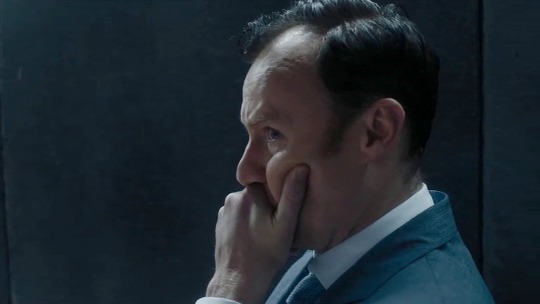
MYCROFT - big brother represents Sherlock’s rational side, logic and reason, the mind, just-brain. His immediate superior is Lady Smallwood who also opperates under the code name ‘love’. This could be a possible reason for Mycroft’s janus-facedness regarding his brother - sometimes he’s cold, emotionless, even cruel and then again constantly concerned, protective and caring. While in the previous episode Mycroft, as usual, monitores and controlles everything, this changes noticeable in TFP. Suddenly ‘big brother’ seems to have lost much of his former omnipotence. Now it is Sherlock who sets the pace and leads the way. Maybe the reasons for those changes in Mycroft’s personality have to do with Lady Smallwood’s invitation for a drink (a small shot of chemistry?). She gave Mycroft her number ... one wonders if he ever called her back. The question is, will the chemistry of love overrule the pure rational mind in the end? This conflict could become an important confrontation if the story continues.
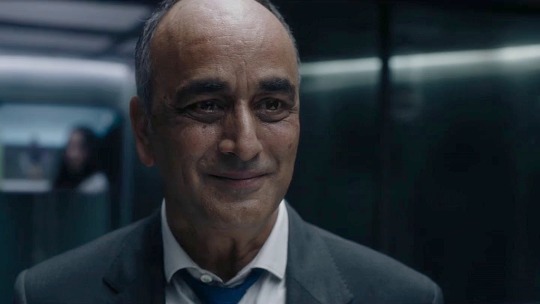
THE GOVERNOR - he is Mycroft’s subordinate and therefore can be viewed as the extended arm of the government ... the brain. Shortly before Sherlock, Mycroft, John and the Governor find themselves locked in Eurus’ former prison cell, the audience learns that the Governor of Sherrinford disobeyed the orders of the government, regarding Eurus. He contacted her, spoke to her, even evaluated her and as a consequence the man got compromised. It is John who notices the Governor’s ‘enslavement’ by Eurus but it is already too late. The red alert goes off and Jim enters the stage via speeker system and TV screen. Metaphorically this seems to indicate that - caused by the yearning for love and sex - a certain ‘subordinate’ part of Sherlock’s mind grew curious. Against orders he took a closer look at the concept of emotions, got compromised and as a consequence started secretly working for the ‘other one’. It turns out that this forbidden involvement has serious consequences for the Governor as well as his Wife.

THE WIFE - informations about that character are sparce. There are recorded tapes on which Eurus can be heard talking to the Governor about his Wife. Eurus asks him to meet her because 'I can fix her for you’ and she promises to give her right back ‘good as new’ afterwards. The Governor hesitates. He thinks it’s not right what Eurus is proposing. Then Eurus asks the man repeatedly if he really trusts his Wife. The Governor wants her to stop saying these things, which he considers ‘completely inappropriate’.
In a nutshell: Eurus wants to ‘change and fix’ the Governor’s Wife. The husband hesitates and fears that such a change could be not right, even completely inappropriate. The man’s trust in his Wife seems also to be of great importance.
As mentioned above, I view the Governor as part of Sherlock’s rational mind, compromised by emotions, resulting from a lack of love and sex. In my opinion, the Wife can then only represent traditional John, who lives in a ‘legal’ relationship - a just-friendship - with Sherlock, thus the marriage. Eurus, Sherlock’s emotional side, wants to change that character - this situation - into something new, something that could still be interpreted by some people as ‘not legal’. The curious and compromised part of Sherlock’s mind fears,that such a change might be not right, even completely inappropriate. What else could that be than a metaphor for Sherlock’s desire to change John from ‘legal’ eternal just-friend to ‘illegal’ lover?
Eurus’ challenge
Imprisoned in Eurus’ former cell, Sherlock, Mycroft, John and the Governor are confronted with the first task. Eurus, Jim and the Governor’s Wife are connected to them via TV screen, the little girl on the plane via audio. The Governor’s Wife can be seen sitting in a chair, handcuffed and gagged, while Eurus announces that she will shoot the woman in about a minute ... unless ...
‘You want to save the Governor’s wife? Choose either Doctor Watson or Mycroft to kill the Governor. You can’t do it, Sherlock. If you do it, it won’t count. I’ll kill her anyway. It has to be your brother or your friend.’

That’s a clear demand. In order to save the Governor’s Wife, the Governor himself has to die and Sherlock must decide who shall kill the man ... Mycroft or John. Without any hesitation the Governor is willing to sacrifice his life for his Wife. Mycroft refuses rigorously to shoot the man. John tries to do it but also fails in the end. In his desperation the Governor takes the gun out of John’s hand and shoots himself. This sacrifice doesn’t save the Governor’s Wife though. Sherlock wasn’t able to accomplish the task as demanded and so Eurus shoots the Governor’s Wife as threatened.
My reading of that task: Sherlock has to decide if the compromised part of his brain should be erased either bei his rational mind or by his supressed desires in order to enable the further existance of the ‘legal’ relationship, the eternal friendship with John. This turns out to be impossible. And so the compromised part chooses to erase himself. But Sherlock’s emotional side doesn’t allow him to back away from this important decision and erases the eternal friendship anyway.
The first task and Series One
The first task of Sherrinford is definitely linked to Series One. The eloquent and talkative serial killer in A STUDY IN PINK, Jeff Hope, who is sponsored by Jim, persuades Sherlock to follow him. There is a strong motive of curiosity that finally overrules Sherlock’s rational mind and his common sense - the orders of the brain - until he willlingly puts himself in great danger just to understand the WHY and the HOW (’I don’t like not knowing’) ... all of this mirrows the interaction between the Governor and Eurus, who calls herself ‘Jim’s revenge’.
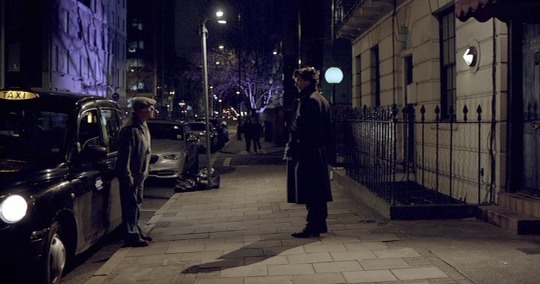
‘It’s murder, all of them. I don’t know how, but they’re not suicides, they’re killings’ ... the same can be said about the first task of Sherrinford. The Governor kills himself, he commits suicide but actually it's murder.
’I didn’t kill those people, I spoke to them and they killed themselves’ ... that’s what Jeff Hope tells Sherlock about his victims. The Governor of Sherrinford tells that Eurus once talked to a doctor and as a consequence the man killed himself and his family.
‘If I wanted to understand, what would I do?’ - ‘Let me take you for a ride.’ - ‘So you can kill me too?’ - ‘I don’t wanna kill you, Mr. Holmes. I’m gonna talk to you ... and then you’re gonna kill yourself.’ ... apparently the Governor was driven by the same motivation as Sherlock. He got curious about Eurus, wanted to understand her. His curiosity grew stronger than his common sense and then he talked to her.
But ASIP isn’t the only episdoe of Series One from which certain motives turn up in the first task of Sherrinford. There is also THE BLIND BANKER. This outstanding episode gives the impression to be the user manual for the whole show (About series one). As mentioned in this old post, the showdown in the Black Tramway Dragon Den presents two Johns and two Sherlocks. This happens because of a missunderstanding. General Shan mistakes John for Sherlock and this turns John - for that particular scene - into a Sherlock-mirror while ‘his pretty doctor companion’ Sarah becomes a John-mirror.

In the Dragon Den John as well as Sarah are bound to a chair and both are threatened to be shot. While Sarah sits in front of a massive crossbow armed with an arrow, General Shan aims her gun at John’s head, even pulls the trigger, but there is no bullet in the chamber.

The way the Governor’s Wife sits bound to a chair in TFP, gagged and threatened to be shot, recalls the showdown in The Blind Banker with John and especially Sarah, who is also gagged. And because of the extraordinary mirroring in that scene both characters represent John (while John is at the same time also a Sherlock-mirror), which means that in this quite similar situation in TBB two Johns happen to sit bound to chairs, threatened to get shot.
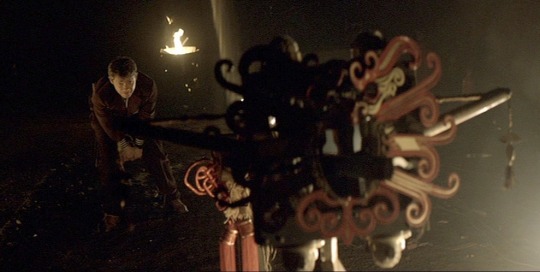
General Shan is quite interesting as well, especially regarding her name (’the clue’s in the name’ says Jim in TGG). The Chinese character ‘shān’ means ‘mountain’ and its pictograph 山 is meant to show a series of mountain peaks (X). Only one quarter turn is required and that pictograph suspiciously looks almost like an E. How much of a coincidence can it be that Sherlock’s secret ghost sister is first introduced as ‘E’? Then she turns into Faith,Elsa/Eliszabeth and later reveals herself to be Eurus before she aims her gun at John and shoots him ... immediately after he stands up from a chair.

What also comes to mind is the small ‘printing error’ regarding the ‘explosive’ glycerol molecule formula in TRF, which should, correctly written, depict three times ‘OH’ but acutally shows OH-OE-OH (Under the microscope 2). A quite similar letter-turning-game can be played with M&W and there’s also that big E that turns up on a promo shot for S1. (source)

Beyond Series One
As mentioned at the beginning of this post, linking the first task of Sherrinford to Series One fits perfectly on a first glance. There are clear connections with ASIP and TBB. And yet, that comparison doesn’t work out entirely smoothly because there’s something more contained in Eurus’ fist experiment, something that doesn’t happen in Series One. While ‘Saving John Watson’ is clearly a main theme of the show from the start, there is another very strong theme addressed in the first task of Sherrinford, something that emerges only beyond Series One. I’m refering to the SACRIFICE-MOTIVE that starts playing a main role only in Series Two ... The Reichenbach Fall. On Bart’s roof Sherlock has to choose between his own life and the lives of his friends, above all John’s.

'Oh, just kill yourself. It’s a lot less effort. … Okay, let me give you a little extra incentive. Your friends will die if you don’t.’ - ‘John.’ ... this is exactly what the first task of Sherrinford addresses as well. In order to save the life of the Governor’s Wife, the Governor has to die and ultimately he kills himself.
Like the Governor of Sherrinford in Eurus’ first task, Sherlock too chooses to sacrifice his own life in that scene on Bart’s roof, to save the ones he loves. It is Jim (Eurus’ revenge) who forces that decision on Sherlock by taking his own life first. Both characters manoeuvre themselves in a deadlock position by talking each other into suicide. They are ‘killing with words’. That’s the same method Jeff Hope uses in ASIP and Eurus in TFP.
Same methods ... and then ‘the Government explodes’
As mentioned above in the character description, Mycroft seems to represent Sherlock’s rational side, logic, reason, the mind - the brain. Applying this metaphor to the story told in Sherlock BBC, some interesting connections and motivations become visible. And it looks like all of them have to do with Sherlock’s fear that - under certain circumstances - he could ‘lose his mind’. There are some characters involved, who decide to end their lives in a very similar way ... by destroying their brains.
On Bart’s roof, Jim takes a gun to his mouth and shoots himself. He sacrifices his life in order to force Sherlock to do the same, if he wants to save the ones he loves.
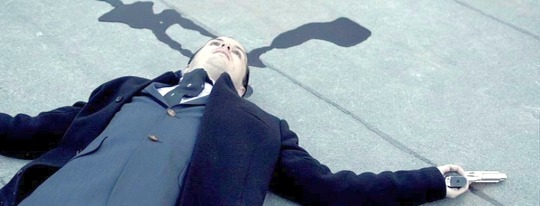
Sherlock sacrifices his own life and although he chooses a different method, the outcome is the same - head bashed in and blood on the pavement.
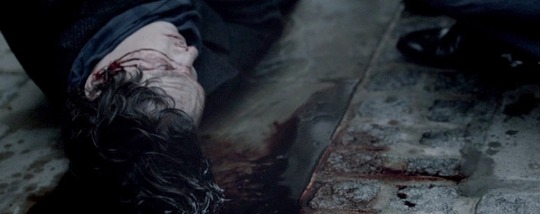
Emelia Ricoletti wants to make her death count. Her suicide in TAB - both fake and real - mirrors Jim’s, Sherlock’s and Irene’s (although in ASIB there are no visuals of the Woman, respectively of her doppelgänger in the morgue). Emelia’s death becomes the birth of the ‘league of avenging brides’ and later of ‘ghost-sister’.
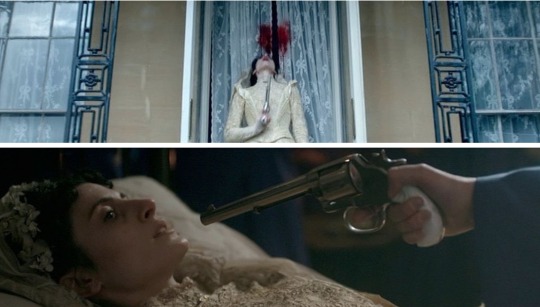
Blood on the floor, a destroyed brain and a gun beside his hand applies also for the Governor of Sherrinford when he sacrifices his ‘compromised’ life for his wife.

‘I’m remembering the governor’ ... with these words Sherlock decides to go the same way as David, when he tries to back out of Eurus’ fourth task, because it’s impossible for him to erase either Mycroft (rational mind) or John (his desire for the eternal just-friend).

And of course, the massive bomb inside the Underground train compartment at Sumatra Road - the station which was closed before it ever opened - the bomb that threatens to destroy the Houses of Parliament in TEH should not be forgotten either. It’s his highly ‘explosive transport’ with which Sherlock is dealing in this adaptation, after all. :)

This imagined explosion - stopped and prevented by Sherlock in the very last second - is mirrored in TST, when Mycroft reminds Sherlock of his old, rewritten childhood story 'Appointment in Sumatra’. The scene ends literally with Mycroft’s head - and the queen’s picture - exploding and shattering into pieces (And then the government explodes).
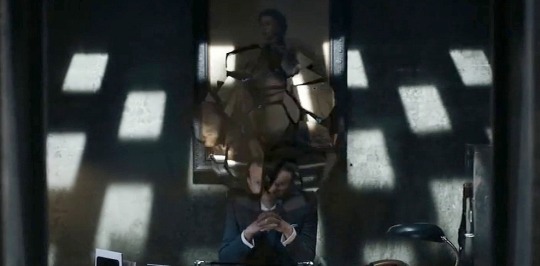
Those pieces then merge into the transition of the shattered plaster bust, owned by Mohandes Hassan. That man’s first name is linked with a winged god of love and lust, armed with arrows, while his family name is linked with an Irish deer. (The plaster bust owners)

All those destroyed brains seem to point at one and the same problem and Sherlock explains that ‘problem’ in quite clear words in The Reichenbach Fall, when he talks about ideas planted in heads and the impossibility to erase them again from that place - the mind:
“You’re gonna have to be strong to resist. You can’t kill an idea, can you? Not once it’s made a home ... there.”
That’s what all those ‘killings’ and sacrifices and shuttered brains are about, in my opinion. Sherlock wants to erase a certain idea from his mind. He is at war with himself over this problem because a part of him considers that idea ‘not right’ maybe even ‘completely inappropriate’ as the Governor puts it when he talks about Eurus’ suggestion ‘to change and fix his wife’. Sherlock is driven by his long neglected emotions to change the traditional relationship with his eternal just-friend into something new. The idea of a romantic and sexual relationship with John has made a home inside his brain and whatever Sherlock tries to do to erase that idea .... it’s completely futile. That particular idea seems to be simply indestructible. If you can’t kill the idea, destroy the head ... before you lose your mind. And that’s a deadlock position in itself.
The first task and Series Four
From The Reichenbach Fall onwards the SACRIFICE-MOTIVE moves significantly into focus. Saving John Watson, even at the cost of Sherlock’s own life, is the main theme that runs from now on like a scarlet ribbon throughout the story. Though heartbroken, Sherlock marries John and Mary in TSOT to protect his eternal friendship with Dr Watson. He murders Magnussen, the keeper of (his own) secrets and scandals, also to protect eternal friend and facade and he willingly goes away on a suicide mission, never to return. But then in TST Mary (his facade) - who secretly works for Mycroft - throws herself in front of Sherlock to take Norbury’s bullet. Sherlock’s facade breaks and crumbles and now everything starts to change. Without facade, Eurus, his emotional side, can’t be contained any loger.
‘Save John Watson. Save him, Sherlock. It’s up to you. Save him. The only way to save John ... is to make him save you. Go to Hell, Sherlock. Go right into Hell, and make it look like you mean it. Go and pick a fight with a bad guy. Put yourself in harm’s way. If he thinks you need him, I swear ... he will be there.’
This is Mary’s last advice for Sherlock at the end of TST. Stricktly speaking, one can summarise that whole paragraph in just two words: ‘trust John’. That’s exactly what Eurus wants to know about the Governor’s wife ... ‘do you trust your wife’. And in TLD, the very next episode, Sherlock puts precisely that advice into action. He picks a fight with Culverton Smith, a talkative serial killer who has quite striking teeth. Sherlock lets himself be abducted by that man in order to get killed. John is the ultimate reason for Sherlock’s hazardous plan in the first place. None other than John brings Sherlock into that situation. Using Jim’s words from TAB: ‘Doesn’t this remind you of another case? Hasn’t this all happened before? There’s nothing new under the sun. What was it? What was that case?’ Of course, Jim refers with those words to occurrences in ASIB and TRF. Using them in this context, I want to point to the close connections between the Jeff Hope case in ASIP and the Culverton Smith (father of Faith) case in TLD. It’s hard not to notice those Serial-Killer-Connections that take the story backwards to its beginning ... although the ending of both episodes differs quite interestingly.
In ASIP John shoots and kills Hope, the talkative serial killer who had been sponsored by Jim.
In TLD John is shot by Eurus, who calls herself ‘Jim’s revenge’ and the talkative serial killer Smith (father of Faith) goes to prison.
Taking all those connections into account it becomes clear that the first task of Sherrinford isn’t linked exclusively with Series One. It stretches across the whole show on to Series Four. And just like S1 & S4 are linked, the first & the fourth task of Sherrinford are linked as well. In both cases the same characters are moved into focus - Mycroft and John - the one represents Sherlock’s rational mind and the other his supressed sexual desire aimed at the best friend. Both tasks end with a slightly different shooting - same as the relevant episodes in S1 & S4 (ASIP&TLD).
Sherlock has to decide who shall do the shooting ... Mycroft or John.
Sherlock has to decide whom he himself shall shoot ... Mycroft or John.
In the end it turns out that neither of them is able to erase any of the other parts and when Sherlock tries to erase himself (in exactly the same way as the Governor in the first task), Eurus intervenes and catapults Sherlock right away into the Musgrave Riddle ... where the dog lies burried ... wo der Hund begraben liegt ... where the crux of the matter lies. Redbeard, Victor, John in the well.
Therefore the Musgrave Riddle - Sherlock’s fifth task in Sherrinford - should point to the Fifth Series of Sherlock BBC .....
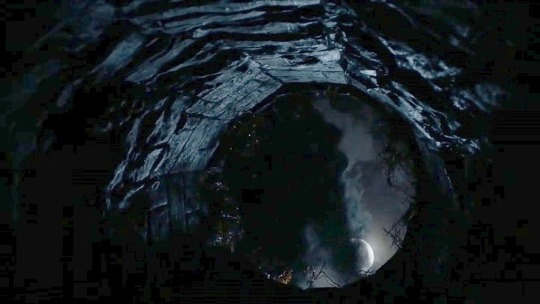
PS:
Some musings about ‘living’ and ‘dying’ in Sherlock BBC
‘Each Sherrinford task gives us the same challenge as the corresponding season, but shows us the exact opposite outcome’ ... wrote @sagestreet in the above mentioned Sherrinford Meta. That’s what I see as well. For example:
In Series One ASIP John shoots Hope and saves Sherlock’s life and Sherlock rescues John and Sarah (John-mirror) from getting shot by the Black Lotus Gang in TBB. The third episode, TGG, is quite special in itself, because of its five-case structure that, just like the five tasks of Sherrinford, also strongly points to five possible series of the show. Therefore not the last case - John’s abduction by Jim and the following swimming pool showdown, interrupted by Irene’s (the naked truth’s) phonecall - should be taken for a Sherrinford comparison. Instead the fourth case is here the relevant one, the one with the fake Vermeer painting about the exploding supernova and the lost child, who cries for help like little Eurus on the plane and Victor in the well. Sherlock is able to prevent the explosion of the fourth bomb and save the child. Everyone lives, only the blind old lady dies, who might represent love, because ‘love is blind’ the saying goes (Love, actually).
The first task of Sherrinford, on the other hand, ends with the death of both, husband and wife, who represent Sherlock and John.
The big question now is ... what outcome is the good one and what the bad one? In real life, of course, dying would definitely be the bad thing .... but .... on a metaphorical level, where ‘dying’ and ‘death’ can be translated into ‘fallin in love’ or ‘having sex’ (la petite mort), the same thing would then stand for something good, wouldn’t it? When Jim and Sherlock meet on Bart’s roof, the consulting criminal greets the consulting detective with this words, while ‘Staying alive’ from The Bee Gees plays on the phone in his hand:
"Ah. Here we are at last – you and me, Sherlock, and our problem – the final problem. Stayin’ alive! It’s so boring, isn’t it? It’s just ... staying.”
According to Jim, the final problem is ‘just staying alive’ and this state of being seems to be extremly boring for Jim, who calls himself ‘Mr Sex’. If Sherlock considers sexuality as a copletely unnecessary, while distrubing influence - just dispensable transport - as one would expect from a traditional Holmes interpretation .... how would his neglected sex drive react in case someone gave Mr Sex a voice to express his own view on the matter? What extremely boring existance it must be to play the role of Mr Sex, when Sherlock chooses to live a celibate life, because all that matters to him is the work. Especially when Sherlock is living in close proximity to John Watson. Staying alive under these circumstances must become a real challenge for Mr Sex. No wonder Jim longs for revenge and turns into a criminal mastermind just to get Sherlock out to play a great game with him. And most likely Anteros is also very not amused about such a love and sex scorning behaviour .... :)
Another scene that comes to mind immediately is the one in TLD, in which Culverton Smith tries to suffocate Sherlock. The dark John-mirror can only confess his scandalous secret in the presence of people who are under the influence of a memory inhibitor and not able to remember anything afterwards. Before Smith takes any action he demands from Sherlock to say ‘I don’t want to die’. The way Sherlock utters those words feel entirely honest and heartbreaking. One wonders which version of the great detective is here afraid of dying ....
the traditional Holmes, who would rather not change anything because he lives in fear to lose his eternal friend forever if he tells the truth or
the modern, liberated Sherlock, who desperately wants to break free from his prison but is still not allowed to and forced again into silence
And which version of John breaks into the hospital room and saves once again Sherlock’s life? It seems to be traditional Dr Watson, who represents Sherlock’s desperately unspoken desire for his eternal friend, the part of him who shys away from any change. That rescue-scene with the fire extinguisher is the counterpart of the one in TRF, in which Jim breaks open the glass cabinet and ‘frees the crown jewels’. Which break-in can be considered positive and which one negative? Is freeing and helping themselves to the ‘crown jewels’ good or bad? Is it good or bad when traditional Dr Watson saves Sherlock’s life again and again and again?
‘”Liberty in death” – isn’t that the expression? The only true freedom.’
That’s what Sherlock says in THOB, when he refers to the origin of the HOUND aerosol that triggers fear and terror - in other words: the chemistry of love is in the air. Could therefore a metaphorical ‘death’ be the way to Sherlock’s and John’s final liberation? If there are two versions of John and Sherlock - a traditional, closeted pair & a future, liberated pair - wouldn’t it be only logical to assume that one of those pairs has to die, to enable the existance of the other pair. In that case ‘dying’ is also an ambigious aspect in Sherlock BBC. Good or bad depends solely on what version will die and what version will live.
.
Thanks for reading that far and thanks @callie-ariane for the scripts.
July, 2022
#sherlock bbc#the final problem#tfp#first task of sherrinford#the governor and his wife#revisited#metaphorical reading#five tasks#five episodes#tapestry of sherlock bbc
37 notes
·
View notes
Text
Nikolaj Coster-Waldau has eight seasons of faux Medieval cred thanks to his character Jaime Lannister on Game of Thrones. In an upcoming production by the BBC and CBS Studios he gets to recreate some actual 11th century history in the series King and Conqueror.
Nikolaj's character never got to rule the Seven Kingdoms. But in King and Conqueror he portrays William the Conqueror who became King of England and ultimately the founder of the royal line which still reigns in London.
George R.R. Martin was heavily influenced by English, French, and Scottish history in ASoIaF. GRRM may have had William the Conqueror in mind when writing about Aegon I Targaryen.
In 1066, the English King Edward the Confessor died without an heir. As if dying without a direct descendant to claim the throne wasn't one of the most chaotic things a king could do, Edward took it a step further: He allegedly promised the throne to both his brother-in-law, Harold Godwinson, and to a distant relative, William of Normandy.
Harold and William weren't the only ones with a claim, either. While the pope endorsed William's claim, the resulting war of succession would force Harold to fight Harald Hardrada, the king of Norway, who also claimed the thrones of Denmark and England and invaded the latter alongside Harold's brother, Tostig. Anglo-Saxon King Harold would have to defeat Harald before meeting William and his Norman invasion at the Battle of Hastings, all in the same year.
If that sounds to you like a lot of drama that could easily be its own television series, you aren't alone. CBS Studios and the BBC are teaming to produce "King and Conqueror," a show about this most pivotal event in English history. James Norton ("Happy Valley") and Nikolaj Coster-Waldau ("Game of Thrones") are attached to be the titular King Harold and William the Conqueror, respectively.
[ ... ]
Historians might disagree on whose side of the story is more accurate, but screenwriters and producers agree that no matter what happened, the 1,000-year-old story will make for great television. Michael Robert Johnson ("Sherlock Holmes") will pen the series while Baltasar Kormákur ("2 Guns") will direct.
"King and Conqueror" begins production in 2024.
There's actually a physical artistic link between the account of William's conquest in the 1060s and Game of Thrones.
After William's victory, his half-brother Bishop Odo was apparently the commissioner of a tapestry embroidered with scenes which tell the epic story of William's conquest. The cloth, now known as the Bayeaux Tapestry is an amazing 70 meters long. It can be viewed here.
So volunteers at the Ulster Museum in Northern Ireland where GoT was produced created a tapestry in the style of the Bayeaux Tapestry which tells the story of all eight seasons of GoT. See our 2019 post about it.
#game of thrones#house of the dragon#nikolaj coster-waldau#jaime lannister#william the conqueror#king and conqueror#bayeaux tapestry#guillaume le conquérant#gra o tron#trône de fer#kampen om jerntronen#pemainan takhta#a guerra dos tronos#juego de tronos#trono di spade#taht oyunları#trò chơi của ngai#valtaistuinpeli#hra o trůny#isang kanta ng yelo at apoy#гра престолів#왕좌의 게임#权力的游戏#ゲームの玉座#صراع العروش#تخت کے کھیل#गेम ऑफ़ थ्रोन्स#গেম অব থ্রোনস#ಗೇಮ್ ಆಫ್ ಥ್ರೋನ್ಸ್#игра престолов
15 notes
·
View notes
Text
AMY'S DAILY FIC REC
Here we go! We have returned! This time with some BBC Sherlock, BBC Merlin and Stranger Things
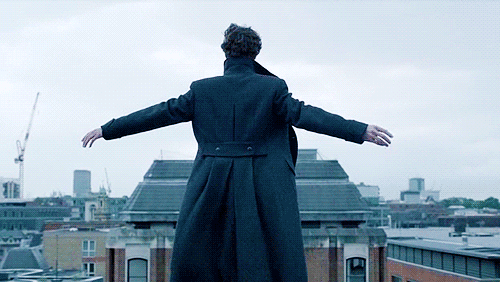
*Complications - EstravenAi
20k, 15/15, Johnlock, Medical Trauma, Permanent Injury, Angst with a Happy Ending
Heat and noise...
After John is seriously injured during a case, he and Sherlock must deal with the fallout.
*The Imaginary Boyfriend - Oliver_966
2k, 1/1, Johnlock, The Yard finds out, Humor, Angst, Fluff, Married Johnlock
John and Sherlock met after Johns first leave, and have been in a relationship for years.
Sherlock hasn't ever mentioned this to anyone at the Yard, and when he does they turn it into a joke.
Sherlock doesn't care though of course, because he knows his John is real.
*Illusory Correlation and Confirmation Bias - VanillaBroompolish
10k, 6/6, Johnlock, Greg is a good friend, Molly Hooper, Sally Donovan, Relationship Reveal
Looking back, there were a few things that should’ve tipped Greg off long before that night at the pub. A few things Sherlock left fairly obvious, that on reflection, made Greg question how he’d gotten his job in the first place.
*Limits - WhatLocked
41k, 23/23, Johnlock, Baby Watson, Mentions of Infidelity, Mary Ships Johnlock, Mycroft is a good brother and uncle, Arguments and Confusion, Fluff and Smut
Basically, John leaves, without a trace, after discovering that Mary has left and the baby is not his.
Sherlock gets frantic, Mycroft gets sassy and limits are reached.
Sherlock somehow acquires a baby that he didn't expect to meet and eventually John comes home.
That is when things get tricky...
*Sharp Angles and Thin Measurements - wistfulpisces
TRIGGER WARNING, 1k, 1/1, Sherlock-centric, OCD, Eating Disorders, Unilock, Stream of consciousness
Sherlock has always been sharply aware of his body.
Perhaps too aware for his own good.
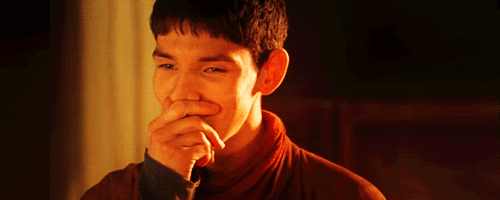
*For Now and Always - merpancake
996, 1/1, Merwaine, Proposal, Short and lovely
It was a joke, surely just meant to be a joke, but- suddenly Gwaine could see a future unrolling in front of him like a tapestry.
*Mornings - ShipsUncloaking
320, 1/1, Merwaine, Short and Fluffy
Merlin and Gwaine have been married for a year, and at this point their morning routine is pretty much set in stone.
*to spill soup (down someone else's front) - southfarthing
615, 1/1, Gwen & Merlin, Gwen/Arthur, Fluff and Humor
A visiting noble says something rude. Merlin and Gwen try to out-friend each other.
*the things that you hold - EachPeachPearPlum
1k, 1/1, Merwaine, Gwen/Lancelot/Arthur, Magic Reveal, Fluff
“I’m a sorcerer,” Merlin announces, the second Gwaine closes his bedroom door behind himself (our bedroom, Gwaine would insist, but Merlin’s been hesitating on that, holding back until Gwaine knows all of him, because how can anything be theirs when Merlin is keeping so much from him).
Gwaine stares at him, somewhere between a little bit startled and actually alarmed, and Merlin curses internally. Idiot, he tells himself. You idiot, this wasn’t the plan.
*Little Miracles - Lola_Rose_Robins
3k, 1/1, No Slah, Parent Merlin, Parent Arthur, Queer Platonic Relationship, Family Fuff, Adoption
One of Merlin and Gaius' patients dies in childbirth, leaving behind two young children with nowhere to go. Merlin decides to take them in and pretty soon the entire castle is fully on board.
*A Golden Coin (With Two Sides) - Lilmia_Casand
939, 1/1, Merthur, Fluff
Merlin gets hit by a spell that gives him dragonish tendencies, it's really too bad that Arthur's hair is as golden as Merlin's brand new hoard. Because Merlin might try to hoard Arthur and that would just be- soft, fuffly, adorable. I could go on.
*It's The Little Things - KellyDrake6
1k, 1/1, Merlin & Arthur Pendragon, Gwen, Language of Flowers, Fluff, Hugging
Arthur notices Merlin hasn't smiled in awhile so gives him flowers to cheer him up
*Faithful Are the Wounds of a Friend - VikingSong
4k, 1/1, Merlin & Arthur Pendragon, Gwen, Knights of the Round Table, Scar reveal, Magic reveal, Angst and Humor and a Happy Ending
Arthur catches sight of a scar on Merlin’s back which he can’t explain, so he asks each of the members of the Round Table if they’ve seen it, too. They have...but it wasn’t the same scar.
*The resident oddball - Lola_Rose_Robins
4k, 1/1, Aroace Merlin, Aroace Leon, Stimming, Oblivious Arthur, Autistic Merlin, George is a good friend, Arthur knows about Merlin's magic
Merlin's autistic, he's got some sensory issues, his friends help him.
*Cloth Armour Series - a_chilleus
2 works, 6k, No Slash, Autistic Merlin, Hurt/Comfort, Canon Era, Sensory Overload
He brushed his hand over the smooth metal of the freshly polished helmet, smiling at the cold texture, before picking up the breastplate. He carefully wiped the mud off the shoulders, revelling in the soft swish sound of the cloth against the metal, moving slowly simply to draw out the satisfying sound for longer. There was no hurry.
*Scenes From A Summer - vensre
2K, 1/1, Merthur, Autistic Merlin, First Kiss, Gwen, Gaius, Hunith
If Merlin had Asperger Syndrome on top of being magical, his life might be something like this.
*Taking a Chance - cordeliadelayne
2k, 1/1, Lancelot/Merlin, Arthur is a good friend, Light Angst, Getting Together
Merlin doesn't think that having something of his very own is too much to ask, not this once.
*On Shapes and Stories - TyalanganD
2k, 1/1, No Slash, Dyslexia, Light Angst, Humor
The spell book that Gaius gave Merlin upon his arrival in Camelot, is a really precious gift. It would be even more precious if Merlin could fucking read.
*Breathe - kriadydragon
9k, 1/1, Gen, PTSD, Friendship, Torture, Hurt/Comfort
Merlin saves the day - yet again - when he manages to get an injured Arthur and knights to safety. But Merlin's troubles are far from over when an investigation into what had happened to the king and knights leaves him in a bad way, and now it's Arthur and Gwaine's turn to be there for him.
*In Deep and Out of Control - LFB72
5k, 2/2, Gen, PTSD, Hurt/Comfort, Major Character Injury
Arthur and Merlin are trapped with no means of escape. Merlin is injured and struggles to control himself as a past trauma comes back to haunt him
*The Time Tried our Souls, and Through the Darkness we Overcame - mollrach13
8k, 1/1, Gen, Hurt/Comfort, Grief, Healing, Torture, Magic Reveal
A fill for this prompt at kinkme_merlin: Merlin goes through a lot of trauma and has gotten very used to hiding it, moving on (or at least appearing to), and coping silently and without anyone noticing, because most of the time no one can know something happened. One day something traumatic happens to him, which everyone knows about, and everyone is waiting for Merlin to snap, only for him to...not. Arthur is caught between worried and suspicious, and sets about to get to the bottom of this.
*The Burning Truth - FoiblePNoteworthy
2k, 1/1, Gen, Magic Reveal, Drama, Merlin's Backstory
“My Father was a sorcerer,” Merlin said into the silence.
*Darker State of Grace - Nabula5030
6k, 1/1, Merwaine, Gaius & Merlin, Trauma, Serket Stings, PTSD, Scar Reveal, Chronic Pain, Physician Merlin
While on a patrol gone wrong, Gwaine leaps between Merlin and a serket, taking the sting himself.
*Over, Under, Around, and Through to the Heart - anarchycox
4k, 1/1, Merwaine, Arthur Pendragon, Elyan, Gwen, Fluff, Minor Angst, Secret Courtship, Happy Feels
In Ealdor, you court someone by braiding their hair. Gwaine does not know this. Merlin knows Gwaine does not know this. Which means that braiding Gwaine's hair can be just because Merlin wants to, not because he is really courting the man.
He is really courting the man.
*No Badges to Wear - mollrach13
12k, 7/7, Merwaine, Getting Together, Angst and Romance, Scars
“You could do with a good mark. How a man trails around after King Trouble-Magnet for years without a mark on him is an impressive feat.”
Merlin stills under his touch. It’s only for a short moment but Gwaine feels it none the less before Merlin’s body melts back down into the sheets.
“Oh, you know me,” Merlin says with a small shrug. “Just lucky I guess.”
Or;
You've all read scar reveal fics. Well, this is an anti-scar reveal. With Merlin/Gwaine because there isn't enough imo.
*A Study in Natural Philosophy - Mad_Mauldin
13k, 1/1, Series 01, Daemons -His Dark Materials, Magic Reveal
It wasn't all that unusual for people to hide their daemons; Merlin, however, seems to be taking it a little far.
*take me up, cast me away - redkay
12k, 1/1, Merthur, Canon Era, Pre-slash, Gwen, Gwaine, SO GOOD
In which Merlin has a selective understanding of the term banishment, Arthur needs to lock his doors, and neither of them are half as good at mending themselves as they were at breaking in the first place.
*hide and seek - southfarthing
11k 2/3, Gen, Aithusa, ANGST, Recovery, Happy Ending, Post Magic Reveal, Good Morgana
In Arthur’s more selfish moments, he catches himself wondering whether it would be better if Merlin were dead. Better being at peace than fearing Arthur in a self-imposed exile.
-
On the run from Camelot, Merlin is captured and locked away with a dragon. It is years before Arthur can find him and bring him back.
*Dying to Return - StormDancer
19k, 1/1, Merthur, Gwen/Arthur, Gwen/Lancelot, Future Fic, Angsty but so good
When they try to hang him, he floats.
*
They put him on the pyre at dawn.
He doesn’t burn.
*All the Colours in Disguise - inktomi
3k, 1/1, Gwen/Arthur, BAMF Merlin, Magic Revealed, Humor, Angst
Arthur knows. Arthur knows that Merlin knows that Arthur knows. They don't talk about it. (They don't need to.)
*hide your dragons - southfarthing
6k, 2/2, Gen, Aithusa, Gwen is a good friend, Adorable and fluffy and so good, Humor
'It is clear in the law,' Arthur says. 'No magical creatures allowed in Camelot. Sorry.'
Merlin lifts Aithusa up so Arthur can get a better look.
Arthur blinks. 'I will make an exception because she looks very polite.'
-
In which Merlin tries to raise a very illegal dragon in a very dragons-aren't-allowed sort of place.
*Do You Have Need of Me? - TheActualAuthor
33k, 5/5, Gen, Assasins, Druids, Spy Merlin, Emrys Reveal, Grief, Angst, Identity Crisis
Merlin is Camelot’s spymaster and must reveal himself as such to Arthur when he becomes king.

*chosen family - safi
3k, 1/1, Hurt Steve Harrington, Sickfic, Joyce Byers
Sometimes the best family is the one that we choose, not the one we're born into.
Steve's parents never make him their priority, so when he's sick, he is left to his own devices. When Joyce finds this out, she treats him like one of her own sons and makes sure he gets the care he deserves.
*hungry heart - babadak
1k, 1/1, Steddie, Fluff and Crack, Eddie Munson Lives
The realization should be scary, but his perception of scary went down the drain after beating a demon with a baseball bat in Jonathan Byers' house in '83. And then being tortured by Russians in '85. So, being gay should be... it should be something bigger, he's well aware. But it isn't.
Or: Steve Harrington likes boys and isn't freaking out about it.
*The Steve Harrington Triptych - ouijaboy
6k, 2 works, Steddie, Disabled Character, Angst with a Happy Ending
Sometimes, he wishes it had been Vecna. At least they could’ve done something about that.
*Ignore my hurts (Silence my cries) - MossTheMarauder
3k, 1/1, No Slah, Head Trauma, Chronic Pain, Vision Impairement, Steve-centric, Child Abuse
It turns out there’s only so much damage a brain can take before something has to give, and when that brain frequently gets treated like a pinball perhaps side effects should have been expected sooner. Having said that, Steve didn’t realise the permanent harm being done until it was too late to stop it; not that he would have if it meant the people he cared about getting hurt.
#far too many fics dear god#bbc sherlock#johnlock#sherlock holmes#sherlock fanfic#bbc merlin#merthur#merwaine#stranger things#steddie#steve harington#amy's fic rec
63 notes
·
View notes
Note
I, T and X <333
Thanks for the ask bestie, this was very fun!!
I - Has tumblr caused you to stop liking any fandoms, if so, which and why
BBC Sherlock. I really wanted to watch this show when it was all over tumblr and all my friends were watching it back in like 2014, but I never got around to it. Eventually, people stepped back and were like "actually, so much about this show sucks so much", and I was just kinda glad I'd never actually watched it yet and now I won't. If I want Sherlock content, tbh, I'll probably just rewatch "Elementary, Dear Data" from Star Trek: TNG. Or finally finish the Enola Holmes stuff.
T - Do you have any hard and fast headcanons that you will die defending, about anything at all (gender identity, sexual or romantic orientation, extended family, sexual preferences like top/bottom/switch, relationship with poetry, seriously anything)
Duke Thomas cannot make direct eye contact with people. It gives him a splitting headache. Since eyes both absorb and reflect light, looking directly at someone's eyes creates a sort of feedback loop of light beams for him.
Cass is, in all actuality, older than Jason. However, because there is some ambiguity about her precise age, both of them frequently insist they are the older sibling of the two. They could very easily confirm who is older; they both refuse because they don't want to be wrong.
Steph is more of the common sense in the batfam than people give her credit for. Don't get me wrong, she is far from normal (she is vigilante, she grew up in Gotham), but she is the one with the wherewithal to, idk, solve her problems by actually talking to people. She's clever and witty and quick on her feet and actually some really good and really practical people skills.
Duke and Jason are both functionally immortal for different reasons. (Also, they are good brothers and DC needs to bring back the two of them getting to interact).
Tim doesn't call Bruce "dad" and probably never will. Not because he doesn't see Bruce as his parent, but because "dad" has some very complex connotations for him and he doesn't want to apply those to Bruce. More specifically, because good batdad is canon to me, Bruce is better than what "dad" means to him. (It’s also important to me that Jack does try to be a father to Tim and does love him. But loving your kid is not always enough. Sometimes you still hurt them).
There's definitely something I'm forgetting that I'm even more die hard about, but this is already more than I intended on writing for this one 😂 needless to say this is a fun question. (Also maybe putting this out will kickstart me writing the fics I have planned based on 3 of these)
X - top 5-10 characters who are yoUR PRECIOUS BABIES AND YOU WILL DIE DEFENDING THEM
Tried very hard not to just put every single batkid on this list but know that I would go to war for any of them I love them all so much.
In no particular order
1. Jason Todd -- listen, do I think his philosophy on crime should be applied to the real world? No, absolutely not. Has he done anything wrong ever? Also no.
2. Duke Thomas (bonus: the whole We Are Robin crew) -- if you hate Duke Thomas, meet me in Denny's parking lot. Something is clearly wrong with you and I will right it via blunt force trauma /j.
3. Tim Drake -- Catch me untangling the mess that is his fanon and canon characterizations and weaving a beautiful tapestry out of it. I see so many wrong interpretations about him and I am tired. Very carefully sorting out what should and shouldn't be kept from both fanon and canon every time I write him.
4. Cassandra Cain -- she has done nothing wrong ever and she deserves to be Batman. my favorite weirdgirl ever <3
5. Trevor Belmont -- my wife /p just introduced me to Castlevania and I did not expect to love it this much. Trevor is my babygirl and I would die for him.
6. Sypha -- I love her soooo much and I am dreading any potential romantic arcs to come about since she's the female lead because I really don't think she needs it. Please let her be cool af and single and not ruined in favor of the inevitable contrived romance, oh god.
7. Rise!Mikey -- I started my dive into tmnt content with Rise and then I tried to go back and watch 2012 because people said it was also good but they were so mean to Mikey 😭 I couldn't do it. He is like a squeaky toy to me.
8. Rise!Donnie -- I am captivated by his autism swag. Enough said. (Him and Mikey as a brother duo is so precious to me).
9. Razer -- Watch Green Lantern: The Animated Series if you haven't already. Do it. I promise you will not regret it. I won't say anything because spoilers but I have so much to say.
10. Talia al Ghul -- I am taking a knife to canon and carving out the parts I don't like because she is a good mom, goddammit!
Bonus: Koriand'r. I haven't read enough comics to know much about her, but I respect woman juice everyday for my favorite 6+ ft buff alien woman. (She should get to be huge and strong and I will fight for that).
#ask game#spec-text-ular#dc#batfam#batfam headcanons#duke thomas#stephanie brown#cassandra cain#tim drake#jason todd#just tagging the hc section because i don't want to clog up any other tags with this lol#had a lot of fun with this and ending up writing way more than i expected lol
6 notes
·
View notes
Text
BBC TV Classics: Timeless Shows That Define British Television
If you're a fan of British television, you're likely familiar with the rich tapestry of shows that the BBC has produced over the years. From groundbreaking dramas to beloved comedies, BBC TV classics have not only shaped the landscape of British television but have also left an indelible mark on global pop culture. Let's take a journey through time and explore the timeless shows that define British television.
The Impact of BBC TV Shows on British Television
The BBC, or British Broadcasting Corporation, has been at the forefront of television broadcasting since its inception. Established in 1922, the BBC has played a pivotal role in shaping the cultural landscape of the United Kingdom. With its commitment to public service broadcasting, the bbc.com/tvcode has produced a diverse range of programming that reflects the interests and values of British society.
Defining British Television Culture
From its early days of radio broadcasting to the advent of television in the 1930s, the BBC has been instrumental in defining what it means to be British. With its mix of news, entertainment, and educational programming, the BBC has become a cornerstone of British culture.
The Beginnings of British Television
The BBC's first television broadcast took place in 1936, marking the beginning of a new era in media consumption. Despite the disruptions caused by World War II, the BBC continued to innovate and produce groundbreaking television programming.
The Role of BBC in Shaping Television Landscape
Throughout the post-war period, the BBC played a central role in shaping the television landscape of the United Kingdom. From iconic dramas like "The Quatermass Experiment" to groundbreaking comedies like "Hancock's Half Hour," the BBC set the standard for quality programming.
Evolution of BBC TV Classics
As television technology advanced, so too did the BBC's programming. The 1960s and 70s saw the emergence of classic shows like "Doctor Who" and "Fawlty Towers," which would go on to become enduring favorites among audiences.
Pioneering Shows from the Golden Age
"Doctor Who," which first premiered in 1963, quickly became a cultural phenomenon and remains one of the longest-running and most beloved science fiction series of all time. With its iconic characters and imaginative storytelling, "Doctor Who" continues to captivate audiences around the world.
Modern Classics: Adapting to Changing Times
In recent years, the BBC has continued to produce hit shows that push the boundaries of television storytelling. Series like "Sherlock" and "Peaky Blinders" have garnered critical acclaim and a dedicated fanbase, demonstrating the BBC's ongoing commitment to innovation and excellence.
Iconic BBC TV Shows That Define Generations
From the golden age classics to modern era gems, BBC TV shows have defined generations of viewers with their compelling stories and memorable characters.
Golden Age Classics
Doctor Who: Time Travel Adventures Through Generations
"Doctor Who" first premiered in 1963 and has since become one of the most iconic and enduring television series in history. The show follows the adventures of the Doctor, a Time Lord from the planet Gallifrey, as he travels through time and space in his iconic TARDIS.
Fawlty Towers: Comedy Perfection That Stands the Test of Time
"Fawlty Towers," created by and starring John Cleese, is widely regarded as one of the greatest sitcoms of all time. Set in a dysfunctional hotel run by the eccentric Basil Fawlty, the show's sharp wit and brilliant performances have ensured its status as a timeless classic.
Modern Era Gems
Sherlock: A Contemporary Take on a Classic Detective
"Sherlock," starring Benedict Cumberbatch and Martin Freeman, reimagines Sir Arthur Conan Doyle's legendary detective for the 21st century. With its clever storytelling and dynamic performances, "Sherlock" has garnered widespread acclaim and a devoted following.
Peaky Blinders: Gangster Drama with British Grit
"Peaky Blinders" follows the exploits of the Shelby crime family in post-World War I Birmingham. With its gritty realism and stylish direction, the show has become a cultural phenomenon and has introduced audiences around the world to the world of British gangsterism.
Cultural Impact and Global Influence
BBC TV classics not only reflect British identity but also have a significant impact on global popular culture.
BBC TV Classics and British Identity
From its portrayal of British history and culture to its exploration of contemporary social issues, BBC TV classics play a crucial role in shaping the collective identity of the nation.
Global Recognition and Influence
BBC TV shows have a global fanbase and have been exported to countries around the world. From "Doctor Who" to "Sherlock," BBC TV classics have introduced audiences to the best of British television and have helped to showcase the talent and creativity of British filmmakers and actors on the international stage.
The Enduring Popularity of BBC TV Classics
Despite the passage of time, bbc.com/accounttv classics continue to resonate with audiences old and new, demonstrating their timeless appeal and enduring relevance.
Continual Relevance and Resurgence
Through reruns, streaming services, and DVD releases, BBC TV classics continue to find new audiences and inspire generations of viewers. Whether you're a fan of classic science fiction or gritty crime dramas, there's something for everyone in the rich and varied history of BBC television.
Conclusion
In conclusion, BBC TV classics have played a central role in shaping the landscape of British television and have left an indelible mark on global popular culture. From iconic shows like "Doctor Who" to modern classics like "Sherlock," BBC TV classics continue to captivate audiences with their compelling stories, memorable characters, and timeless appeal.
1 note
·
View note
Note
Hi. Just wanted to know, do you have any horror/gothic Johnlock fic recs? Either ACD or BBC canon is fine. I just want to get creeped out
Reply: I initially started this off by saying that horror is not really my thing, but given the amount of material I’m about to dump on you, I guess maybe it kind of is. 👻😱
First off here are some older lists:
Horror plus romance
Sherlock or John is a ghost
Zombies
And here are some more I’ve enjoyed which tend in that direction:
All Things Will Die, Nothing Will Die (109K, E, Johnlock) by Holly Sykes
Rating: Explicit
Relationships: Sherlock Holmes/John Watson
Summary: Time: January, 1831. Something suspicious is happening at St. Bartholomew’s Hospital: corpses are brought in and sold to the surgeons, but Sherlock Holmes suspects foul play. He’s not alone: at Guy’s Hospital, Doctor John Watson refuses to pay twelve guineas for a body that he fears has been tampered with.
Danger Nights by khorazir (23K, T, Johnlock)
According to folklore, the nights between Christmas and Twelfth Night are the most dangerous of the year. During them, the Wild Hunt rides, and ghosts and demons come out to haunt unsuspecting and misbehaving folk. An investigation of a series of strange occurrences leads John and Sherlock to Hay-on-Wye on the Welsh Marches, to face ghosts weird and ancient as well as close and personal – and perhaps to start the new year on a more hopeful note than the previous one.
Haunted by Vulpesmellifera (22K, E, Johnlock)
Plagued by the past, John moves himself and his daughter to a new flat for a fresh start - and it's not 221B Baker Street.While he grapples with new knowledge and old guilt, he's confronted with odd neighbors and strange noises in the night. But is it the new flat, or is John Watson losing his grip on reality?
He’s Coming to Us Dead by Vulgarweed (13K, E, Johnlock)
The war is ending and the troops are returning. They do not always mean well. Their loved ones are not always glad to see them. A case straight out of an old folktale has deep repercussions for Sherlock and John.
it's not always black and wight by elldotsee (21K, M, Gen)
By the time he turned eight, Sherlock had had more supernatural experiences than he could count or recall. They were simply characters that formed the tapestry of the house, bumps and flickers of a life stuck in the in-between. That is, until he met Victor.
Lightning and Sea Glass by 221b_careful_what_you_wish_for (18K, E, Johnlock)
The mad Professor Moriarty and his reluctant assistant John Watson have reanimated the dead – and the results are beautiful. At least John thinks so. When Moriarty rejects his creation, John disappears with the creature to protect it, sealing their fates together. (Loosely inspired by Mary Shelley’s Frankenstein)
Obsidian and Moonlight by PenelopeWaits (11K, T, Johnlock)
John and Sherlock make a detour on the way home from Baskerville. The question is, which is more inexplicable, the rites of human violence or the depths of human love?
Penumbra by Saki101 (46K, E, Johnlock)
In Maine, there was Collinwood and the three centuries of history that were woven into its walls. In London, there is Holmeswood Manor (or the Manor on Baker Street as the urban legends have it), tucked now into a city street when once its oak woods rolled from the heath to the river. John’s grown up with its stories of ghosts and wizards and things that hunt in the night. They are certainly not going to keep him from interviewing for a residential post at the Manor because he cannot afford London on an army pension and there could not possibly be any truth to the tales.
Puzzlebox by standbygo (9K, E, Johnlock)
A love story with horror. A horror story with a happy ending.
So Closely Allied by j_baillier (10K, T, Johnlock)
She has always been a part of his life but now, she needs to leave.
Still of the Night by michi_thekiller (30K, E, Johnlock)
1.) Curfew must be obeyed.
2.) Streets must be clear by sundown.
3.) If you find yourself out after curfew, seek shelter at the home of a friend, relative, or neighbor whom you know and trust.
4.) Under NO CIRCUMSTANCES should any unknown persons be allowed into the home after curfew.
The Subtenant by khorazir (12K, T, Johnlock)
When you have ruled out the impossible, whatever remains, however improbable, must be the truth. Hence, there can be no doubt about it: 221B is haunted. Sherlock and John set out to investigate their new subtenant and find out more than they bargained for.
The Victim Experience by J_Baillier (16K, T, Gen)
A case takes Sherlock and John deep into the seedy underbelly of the haunted attractions industry. With audiences craving more and more intense experiences, is a real murder the next logical step?
They Mostly Come Out At Night by Tawabids (16K, T, Johnlock)
Mummy Holmes was admiral of the British space fleet, and her sons were gestated in a synthetic womb called an AGU. When something monstrous burst out of a lieutenant's chest and got loose on board a ship carrying the Holmes family, the unborn second son and was left on board. A quarter of a century later, the Orbiter 200B is a floating wreck on the edge of the colonised territory. Mycroft Holmes sends Lestrade and a Royal Navy special ops vehicle, the Baker, to the abandoned ship to learn what can be salvaged.
You might also enjoy these fanvids:
Asylum by AnimaObscure (NR, Gen)
St. Bartholomeus hospital rooftop is a tricky place to jump off. All Sherlock’s nightmares are going to come to life.
Sherlockian Horror Story by Nyah86Production (NR, Gen)
Inspired by the Opening Titles from American Horror Story Asylum
The Reichenbach Horror by johnlocklover221 (SFW, Gen)
Takes The Abominable Bride as a jumping-off point for a reinterpretation as a Gothic showdown between Holmes and Moriarty
55 notes
·
View notes
Link
read it on AO3 at https://ift.tt/3k3stoS
by sagestreet
A collection of metas on the sculptures, paintings and tapestries the set designers used on the BBC show 'Sherlock'.
Words: 2932, Chapters: 1/?, Language: English
Fandoms: Sherlock (TV)
Rating: Not Rated
Warnings: No Archive Warnings Apply
Categories: M/M
Characters: Sherlock Holmes, John Watson
Relationships: Sherlock Holmes/John Watson
Additional Tags: Analysis, Meta, Sherlock Meta, Art, Sculptures, this is NOT a fic
September 11, 2021 at 01:37PM
3 notes
·
View notes
Text
Doctor Who: Every Master's Regeneration Explained | Screen Rant

When, why and how has Doctor Who's Master regenerated throughout the course of the series? Originally envisioned as the Moriarty to the Doctor's Sherlock Holmes, the Master has been the Doctor's arch nemesis since the show first made the transition from black and white to color, and has remained an integral part of Doctor Who's rich science fiction tapestry ever since. Presented as the intellectual equal to the Doctor, the Master is another renegade Time Lord, but one that has chosen to use their scientific brilliance to dominate and conquer, rather than to help others.
While a variety of Gallifreyans have appeared on Doctor Who over the years, the Master is the only one, other than the Doctor of course, that viewers have watched evolve over a long period, transitioning through a number of regenerations and taking on several sinister personalities. Despite their inherent differences, the Doctor and the Master have always enjoyed a love/hate relationship, and the two troublesome Time Lords have often teamed up against greater threats before breaking up again in dramatic fashion.
Related: Doctor Who: How Jack Harkness Becomes The Face Of Boe
While the Master has regenerated many times, the process is generally different to the Doctor's, usually occurring unnaturally or off-screen. Nevertheless, the Master's fictional regeneration history is just as fascinating as that of the Doctor and full of dark twists and turns. Here are all of the Master's regenerations explained, only taking into account the absolute canon of televised material.
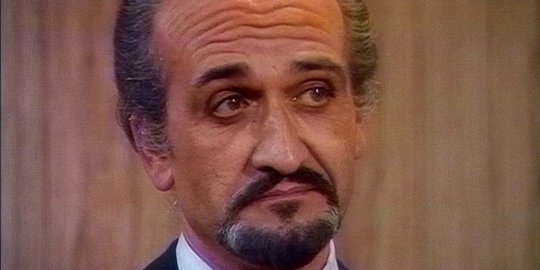
The original, and many would argue the best, Master was introduced in the Third Doctor's debut story, "Terror of the Autons," as the mastermind behind an alien invasion of Earth by the Nestene Consciousness. Despite being the first Master to appear on screen, this iteration of the character is actually the Master's final natural regeneration, having previously renewed himself 12 times off-screen. Delgado helped shape the Master's appearance, persona and speech, and would go on to appear in a total of 8 stories across the Third Doctor's era. Tragically, however, Delgado passed away only a few months after the airing of what would be his final Doctor Who appearance, "Frontier In Space."
For obvious reasons, no regeneration sequence had been filmed and the closing moments of Delgado's final episode see him escape to torment the Doctor another day. The Master returns in "The Deadly Assassin," where it is revealed that the villain was found dying and decayed by Gallifrey's Chancellor Goth, who took him back to their home planet to embark on a dastardly plot together.
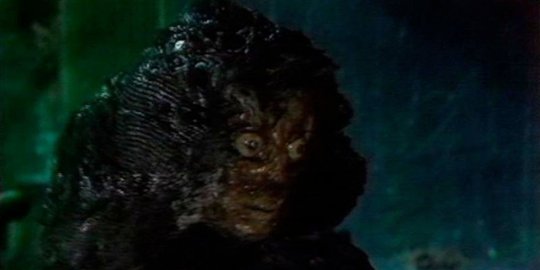
The decaying, corpse-like Master seen in "The Deadly Assassin" was played by Peter Pratt, and there is some debate among fans as to whether this is a severely disfigured version of Delgado's Master, or whether this is the villain's final regeneration and Delgado was the twelfth. In either case, the Master is now dying and out of regenerations, and, in truth, his new grotesque appearance was nothing more than Doctor Who's workaround to reintroduce the character following the death of Roger Delgado.
The Crispy Master returned once again in "The Keeper Of Traken," still in a state of decay, but this time played by Geoffrey Beevers. Nearing a permanent death, the Master steals the power of the titular Keeper in an attempt to extend his life. While the Fourth Doctor manages to save the day, the Master uses his lingering Keeper powers to inhabit the body of Traken's Consul, Tremas, whose daughter would go on to become one of the Doctor's companions.
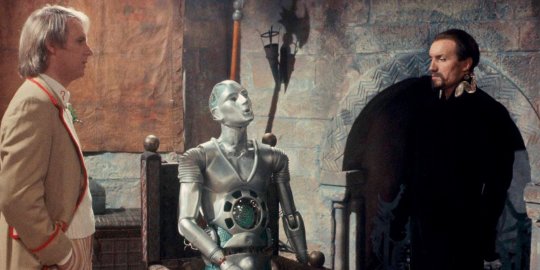
After a period without human appearance, Anthony Ainley took Roger Delgado's place as the second actor to play the Master long-term. Though still technically on his final regeneration, possessing the body of Tremas gave the Master a new lease of life and Ainley continued in the role until Doctor Who was cancelled in 1989, coming up against a total of 4 separate incarnations of the Doctor.
Related: Doctor Who: How Steven Moffat Sneakily Retconned The Valeyard
Though this version of the Master brought back the cunning nemesis figure that had been absent since Delgado's death, viewers noticed how Ainley was evidently being instructed to closely imitate the original Master. Since Doctor Who was cancelled with Ainley still in the role, no regeneration sequence was filmed.
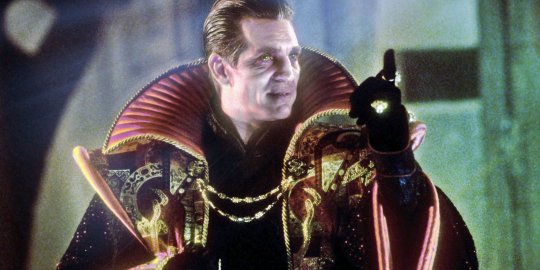
For the 1996 TV movie, Eric Roberts was cast as the new Master, but not before the villain reappeared as a mysterious snake-like creature. Following the end of the original Doctor Who TV run, it's revealed that the Master was captured and executed by the Daleks as part of a new peace treaty with the Time Lords. As per the Master's final request, the Doctor is charged with escorting his former foe's ashes and this trip gives the snake-like Master a chance to escape.
Wider Doctor Who media has revealed this creature to be a Deathworm Morphant; a creature the Master uses as a vessel to survive death. After breaking free of the Doctor's TARDIS, the creature slithers its way down the neck of Eric Roberts' paramedic character, Bruce. Just like Tremas before him, Bruce is killed by the Master's attack, and the evil Time Lord inhabits the human's body, giving himself physical form once again, but retaining the eyes of a serpent.
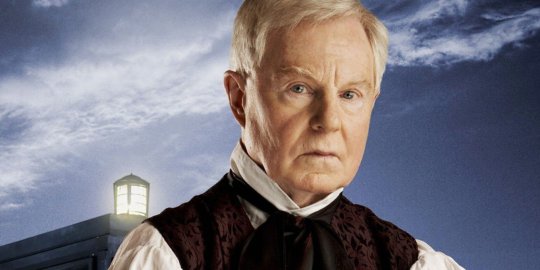
Eric Roberts' version of the Master falls into the Eye of Harmony inside the Eighth Doctor's TARDIS and is subsequently imprisoned. While his misadventures here are well-documented in comics and novels, how the Master escaped is one of several inconsistencies between the movie and main TV series. The revived 2005 Doctor Who did confirm, however, that the Master was granted a new regeneration cycle by the Time Lords in their desperation to recruit powerful allies during the Time War.
In typical Master fashion, the character took his shiny new set of regenerations and ran away, using a Chameleon Arch to temporarily turn into a human and go undetected under the guise of Professor Yana, portrayed by Derek Jacobi. Coming into contact with the Tenth Doctor, the Master's memories are triggered, and he returns to his Time Lord state. Shocked by the sudden transformation of her once placid colleague, "Yana's" former assistant shoots and kills the Master, triggering his next regeneration.
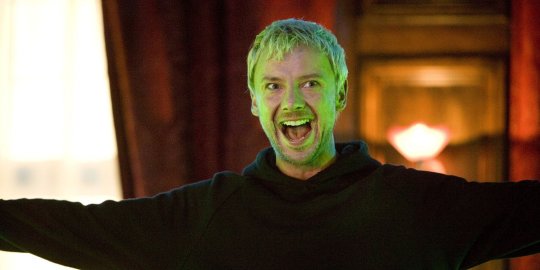
John Simm's Master experienced a rollercoaster of near-death experiences following his introduction as British Prime Minister, Harold Saxon. Using his hypnotic influence and an army of cyborgs called the Toclafane, the Master finally conquers Earth and defeats the Doctor, who he turns into Dobby the House Elf and keeps him as a pet on board his sky base. Thanks to the efforts of Martha Jones, the Doctor is able to return to his regular form and undo the Master's damage. Supposedly in revenge for her suffering, the Master's human wife shoots and kills her spouse and the Time Lord refuses to regenerate.
This is later revealed to be a ruse, as the Master's wife manages to revive her fallen husband in "The End of Time." After clashing with both the Tenth Doctor and Rassilon, John Simm's Master is taken to Gallifrey and "fixed" in return for helping the Time Lords take down their maniacal leader. Leaving Gallifrey, the Master takes over a Mondasian colony ship where he encounters Missy, his next incarnation, and the Twelfth Doctor.
Although the two Masters initially form an alliance, Missy ultimately chooses to fight the Cybermen alongside the Doctor and stabs her past self in the back, triggering her own regeneration.
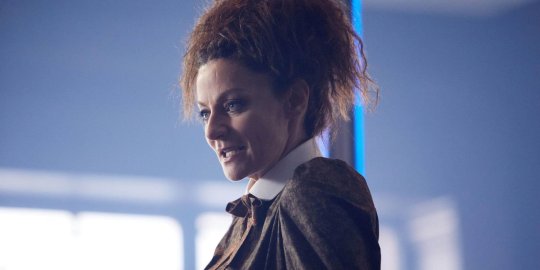
In retaliation for the aforementioned stabbing, John Simm's Master shoots Missy before beginning the regeneration process. Rather than simply heralding the appearance of a new Master, however, Simm's villain proudly claims that the laser blast was so severe that Missy won't be physically able to regenerate, and the Master will supposedly die for good.
Missy's fate has yet to be explored in Doctor Who. It's virtually guaranteed that the Master will return, possibly even in the forthcoming season 12, and there'll no doubt be an elaborate explanation as to how Missy survived her predecessor's attack. Whether fans will see Jodie Whittaker's Doctor face off against Missy or an entirely new Master regeneration, however, remains to be seen.
More: Doctor Who Once Actually Killed A Companion
Doctor Who season 12 premieres in 2020 on the BBC and BBC America.
source https://screenrant.com/doctor-who-all-master-regenerations-explained/
2 notes
·
View notes
Photo

FROM PLANE TO PLANE - inside the plane ... THE FINAL PROBLEM
An attempt to unravel the Sherlock BBC Tapestry based on metaphorical reading
This episode’s theme adds yet another cycle to all the previous ones since TSOT, the great turning point of the story. That’s five cycles in total (HLV, TAB, TST, TLD, TFP). Six, if one counts everything that takes place before Sherlock’s ‘I'm in love’ revelation in TSOT as the great basic cycle of the show. The pattern ‘five to six’ feels a bit familiar, because a similar constellation can be noticed regarding the six bombs, linked with five pips in TGG, the six busts that belong to five owners in TST, the five creators of the H.O.U.N.D. aerosol + Dr Frankland who developed it further or the way Sherlock counts Major Barrymore’s six books about Thatcher in THOB ...
‘Copy of “The Downing Street Years” (a memoir by M Thatcher); one, two, three, four, five separate biographies of Thatcher’.
Maybe there’s yet another, deeper meaning behind those books, a meaning that has nothing to do with Thatcher as a historical figure per se. The etymological origin of ‘thatch’ basically means ‘to cover’ something. Seeing one of those Thatcher busts crumbling down Sherlock’s face in TST, like a melting mask, seems only to confirm this interpretation. The six books on the other hand consist of five biographies + one autobiography and that’s another very prominent theme in Sherlock BBC. The famous biographer of many stories gets finally replaced by Sherlock himself when he takes over John’s blog and becomes his own author. (Batches of six Sherlock’s website)
Anyway, in The Final Problem once again a flight into the past - into Sherlock’s childhood - turns out to be the centerpiece of an episode. Except one young girl, everyone on board, even the pilot (‘the driver’) is asleep. While this flight continues, the girl high up in the sky and a woman locked up in a prison cell at the lowest level on an island surrounded by water, confront Sherlock with different problems. The girl wants to land the plane. The woman wants Sherlock to recognize the truth about his own persona and in order to achieve this, Sherlock has to undergo five tasks. Only then he is presented with the Musgrave Riddle, whose solution will allow him to get the plane back to earth and John out of a well. None other than Jim Moriarty acts as the stationmaster of Eurus’ experiments and when the riddle is solved and the flight reaches its destination, Sherlock finds himself in a surreal world, where two different locations seem to exist side by side and where past and present collide. When Sherlock enters the cockpit, he enters also his lost sister’s room at Musgrave Hall, the ancestral home of the Holmes family, while simultaneously the descending plane is now very close over London.
As is often the case in Sherlock BBC, a similar constellation has already happened before with another plane - the one that takes off by the end of HLV. This flight is supposed to take Sherlock to an undercover assignment in Eastern Europe but instead it carries him right into TABs so called ‘drug induced Victorian fever dream’ and with that, into the great detective’s literary youth. At the end of this case, Sherlock follows Jim Moriarty and ‘flies’ down the Reichenbach Falls. When the plane finally lands and Sherlock returns to London, 221b has become a surreal place where two parallel worlds exist side by side, where past and present collide and where ‘a logician should be able to infer the possibility of ‘Reichenbach’ (Rich Brook) just from a drop of water (emotions)’.
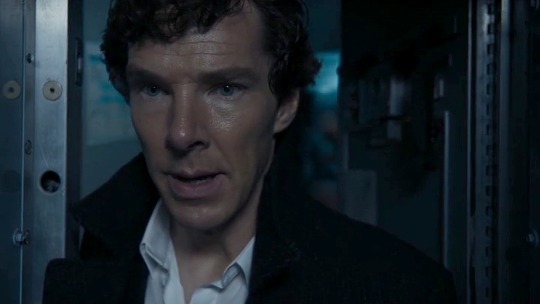
Although the destination of the ‘flight’ in TFP has great resemblance with the one in TAB - both carry Sherlock back to his beginnings and both end in a surreal parallel universe - the second 'flight’ goes still a bit deeper as the previous one. The first flight starts at the end of HLV and subsequentely confronts Sherlock with the birth of his literary character in the Victorian Era, starting at the famous moment when he meets Dr Watson for the first time. The integration of Musgrave and Victor Trevor into the second flight in TFP, connects this episode again to Sherlock’s literary youth but also to his college years, a time in which he hadn’t yet made the acquaintance of Dr Watson. Sherlock has now reached a point BEFORE the beginning, one might say.
TBC below the cut .....
Themes from previous episodes ... repeated and changed:
The episode starts with the motive of the revengeful ghost sister from TAB. This time though Sherlock isn’t confronted with a group of people called a league of furies, an invisible army, a monstrous regiment. It’s only one person that challenges him now, his own sister Eurus, the East Wind, who was locked away and forgotten a long time ago.
The Baker Street explosion in TGG is repeated but this time it takes the opposite direction. Not from the outside in but instead from the inside out (Symbolism of exploding bombs). On a metaphorical level those differently aimed explosions can be connected to the mirror-shootings of Sherlock and Mary in HLV and TST. Meaning: if an explosive idea starts inside Sherlock’s mind palace and goes outwards, it would hit first Sherlock’s heart and only then his facade, Mary. (On behalf of AMO)
The jump out of the living room window in 221b can be associated with Sherlock’s jump from Bart’s roof that ends his confrontation with Jim, the bomber, at the end of TRF. This time though Sherlock isn’t alone. He jumps side by side with John while Mycroft takes the door.
The same pattern is repeated in the very next scene. Sherlock and John land on the roof of a ship somewhere in the middle of an unspecified ocean. Although only Sherlock’s jump down to the ship’s deck can be seen on screen, one can assume that John takes the same way. Mycroft on the other hand, chooses again a different and never explained route to Sherrinford.
Like Baskerville in THOB, the high security prison Sherrinford is also a heavily protected government facility. Other than in Baskerville, Sherlock and John are now accompanied by Mycroft and this time Sherlock doesn’t stop at the first underground level but goes all the way down to the deepest floor (where the bins are kept). Here he meets Eurus, while Mycroft and John interrogate the prison’s Governor.
In Baskervill as well as in Sherrinford experiments are coducted - ‘all totally scientific, under laboratory conditions’. In THOB it is Sherlock who monitors John on a screen, while the doctor is convinced to be exposed to the presence of the HOUND. In TFP Sherlock, John and Mycroft are monitored by Eurus on a screen, while Jim - the HOUND - acts as stationmaster of the experiments. (Like brother, like sister)
The five tasks of Sherrinford
Eurus’ experiments follow the same pattern of ‘five’ that also turns up in the five bombing victims in TGG, the five funny stories in TSOT and the five bust-owner cases in TST. But the five tasks of Sherrinford are set up not only as mirrors for certain events in previous episodes, they seem to be connected to the individual Series of the show as well.
THE GOVERNOR AND HIS WIFE .... the first task is about a suicide that’s acually murder. Furthermore, the sacrifice-motive and a close connection to the fourth task is also highlighted. This provides a mirror for the whole show. The serieal killer theme of S1-ASIP that is repeated in S4-TLD and Sherlock’s attempt to save John Watson, even at the cost of his own life, all of this is brought together in the first task. The first and the fourth task are linked in the same way as S1 and S4. (The Governor and his Wife - revisited&expanded)
THE THREE GARRIDEBS .... in the second task a choice has to be made out of three possibilities. Sherlock faces the same problem in S2-TRF, mirrored by the three fall-solutions revealed in TEH. A loving friendship without sex is placed opposite sex and opposite reason and intellect. Those three aspects are represented by (John-mirror) Molly and the ‘good bye kiss of the hero’, Jim and the ‘let’s elope, baby’ scene and Mycroft who represents Sherlock’s final decision: ‘the pure mind prevails, only the work counts’. But in the end all three possibilities lead to the same outcome.
THE COFFIN FOR LOVE .... in the third task a row of deductions leads to an important revelation: ‘I love you’. Sherlock speaks the words in front of a mirror to Molly, who acts herself as a mirror for John. This reflects Sherlock’s best man speech in S3-TSOT, in which he deduces himself into love, while his facade has already been penetrated and the seed of love planted.
MYCROFT OR JOHN .... the fourth task is about a decision between reason and intellect on the one hand and the desire for love and sex on the other. In S4-TLD Sherlock first distances himself from Mycroft and focuses on his first meeting with John - mirrored by Faith. The ‘sign of two’ is visually addressed by the appearance of two different Faiths ... two different perspectives of John ... eternal friend or potential lover. (From therapist to therapist)
Confronted with the fourth task, Sherlock isn’t able to choose either reason&intellect over love&sex. Instead he wants to stop the experiment by taking himself out of the game. Eurus interferes and literally ‘spiked’ by his emotional core, Sherlock is forced to go deeper until he reaches his ‘ancestral home’ where the heart of the matter lies - or to put it in the synonymus german phrase ‘wo der Hund begraben liegt’ (where the dog lies buried). If there’s indeed this ‘pattern of five’ used as a basis for the Sherrinford tasks, the fifth and final task, the Musgrave Riddle, should point to Series Five (if there ever is one) and the end of the story.
5. MUSGRAVE AND VICTOR TREVOR - the time BEFORE John .... Sherlock falls backwards and sinks into a black mass. When he awakens he lies face down on a table in a grey chamber. The surrounding walls are plastered with old family pictures, some torn and patched together incorrectly (the various SH adaptations maybe). Sherlock finds the food bowl of his childhood dog Redbeard. While he examines room and pictures Sherlock is alternatingly in contact with adult Eurus, John and little Eurus, the girl on the plane. A ‘draft’ (a wind) and a ‘gap’ (mind the gap) lead Sherlock to the realisation that the walls are not real. He pushes them open and finds himself at Musgrave Hall, his ancestral home. Once inside the house, adult Eurus confronts him with the Musgrave Riddle, an encrypted song she once composed, that is supposed to lead Sherlock to his lost childhood dog Redbeard. Adult Eurus calls herself ‘Jim’s revenge’ and she orders Sherlock to find Redbeard, while water starts pouring down on John in the well and little Eurus on the now shaking plane cries for help. Meanwhile John finds old bones and a human skull at the bottom of the well and comes to the conclusion that Mycroft lied to both of them. When he informs Sherlock about his discovery, Sherlock starts finally to remember and Redbeard the lost dog turns into Victor Trevor, the lost boy who called himself Redbeard when he played ‘pirate’ with his best friend Sherlock, who had chosen ‘Yellowbeard’ as his pirate name. Victor visually appears to be in the same position inside the well as John and Eurus confirms that she had been the one responsible for this in the past as well as now. To save John from drowning, Sherlock has to solve the riddle in time. When Eurus repeats the words ‘no one’, Sherlock remembers the wrong dates on Nemo’s (no-one’s) gravestone. He leaves the house and investigates the dates on the ‘funny gravestones’, among which he once used to play as a boy. Sherlock manages to arrange the dates in the correct order and attaches them to the words of Eurus’ song. ‘Seek my room’ turns out to be the solution of the riddle. When Sherlock reaches Eurus’ room and opens the door, he opens also the door to the cockpit of the descending plane. The moment he looks at the little girl and the sleeping pilot next to her, he looks also at adult Eurus in her old and burnt childhood room. Girl and woman become one person and time starts running backwards all the way to the episode’s intro, to the very moment when the sleeping girl on the plane awakens and opens her eyes. Then there’s another short time jump to little Eurus who plays with her toy plane next to a beach .....

And then onwards .....
Temporary condlusion: Sherlock is able to solve the riddle that has been set up for him by his emotional core. Little Eurus on the plane and adult Eurus in her old childhood room merge into one character ... a sign that Sherlock’s persona has developed and reached more harmony. Sherlock manages to save John from drowning at the bottom of the well. The ‘family’ seems to be whole again. Mycroft (reason and intellect) has lost a noticable degree of his former position and power. Eurus (emotional core), although still under tight controll, communicates with Sherlock and together they are able to create beautiful and heartwarming music. Baker Steet 221b gets restored and Sherlock and John continue to solve their exceptional cases .... like they always did and they always will .... after all, they are still Sherlock Holmes and Dr Watson.
Three possible future cases:
THE VENTRILOQUIST’S DUMMY - he sits in the client’s chair and the operator seems to be dressed in black and hides behind the chair

THE CASE OF THE DANCING MEN - cyphers are written on a blackboard in front of the fireplace. They translate into: “Am here Abe Slaney” and are a reference to the canon case of The Dancing Men (X)

THE MYSTERIOUS VIKING - he lies unconscious on the living room floor and John tries to wake him up, patting his face and examining his eye

All three settings refer to subjects that have already come up in previous episodes.
A red balloon is used as head for the ‘dummy of the guy’, sitting in a pushchair, for Guy Fawkes day in TEH and also for John’s head, bound to the client’s chair, in TST. (X X)
The world’s run on codes and cyphers, tells Sherlock in TBB and paired cyphers are the secret code of the Black Lotus Gang in the same episode. (X X)
Initially Sherlock wanted to become a pirate, that’s what Mycroft tells in ASIB and Sherlock calls himself a pirate in TFP. (X X)
This might indicate that the three episodes of a possible futer series could deal with John and the truth about his substitute, a secret finally revealed and Sherlock, sailing the vast ocean of emotions free like a pirate. :)
The big difference
There’s only one big difference, one enormous change, that distiguishes other Sherlock Holmes adaptations from Sherlock BBC, and this is .... Rosie. Little Rosamund, the new life, whose existence Sherlock deduced unexpectedly after his ‘I’m in love’ revelation at the turning point of the story, in TSOT (The elephant in the room A Christmas Tale). By the end of TFP Rosie lives in Baker Street, lovingly nutured and cared for by Sherlock and John. This child has been given a very special name and how that name is meant to be read in this story is explicitly stated by Molly during the christening scene in TST.
‘Rosamund ... means ‘rose of the world’ ... Rosa Mundi
According to Jim’s message in TGG: ‘The clue’s in the name’, the meaning of names really seems to be very important in Sherlock BBC. Molly’s direct reference to precisely THIS rose makes it rather easy to find a more than fitting reference. ‘Rose of the world’ translates into the Latin ‘Rosa Mundi’, which is the name of an actually existing, historical rose, also famously known by it’s botanical name ‘Rosa gallica versicolor’.
About that rose: Rosa Mundi is a sport of the Apothecary Rose (Rosa gallica officinalis) and is probably the oldest and best known of the striped roses. Many legends surround this rose; the most romantic is that it was named for 'Fair Rosamund', mistress of Henry II. Rosa Mundi is also depicted in Botticelli’s work “Virgin Adoring the Sleeping Christ Child”. x x
Versicolor or Rosa Mundi must be one of the most popular of all old roses with its light crimson flowers splashed and striped with shades of pale pink. It grows up to 4 feet and is one of those garden shrubs that makes you stand still for a long while in pure admiration. x
On Youtube: Old Garden Roses-The Gallicas (at 6.01 about Rosa Mundi and the story of Henry II & Eleanor of Aquitaine (parents of Richard the Lionheart and Prince John) and the young lady Jane Clifford, who was that beautiful that everyone just called her the Fair Rosamund.
Additionally: the Spirit of Ecstasy, the bonnet ornament sculpture on Rolls-Royce cars (very prominently set in scene on Lady Smallwood’s car in HLV) is called Eleanor: from the Old French name Alienòr. Queen Eleanor of Aquitaine was initially named Aenor after her mother, and in order to distinguish her from the mother, she was called by the phrase ‘alia Aenor’ that means ‘the other Aenor’ (X).
Painting of Rosa Mundi, Rosa Versicolor: Alida Withoos possibly 1700

And again the clue's in the name ...
As mentioned above, the botanical name of Rosa Mundi is Rosa Versicolor. The word ‘VERSICOLOR’ describes something that has different colours or something that is changeable in colour in different lights (’I’m sooo changeable’ Jim in TGG). This effect can also be called ‘iridescent’ (X X) ... meaning:
having a play of lustrous rainbow colors
varying in color when seen in different lights or from different angles
coloured like the iris or a rainbow
Little Rosie - the so called 'elephant in the womb' by the creators of Sherlock BBC at SDCC (ca 28.00 in) - has been given the name of a famous rose whose synonym translates into ‘RAINBOW’. And by the end of TFP this sparkling little rainbow has found a home in 221b Baker Street. The words chosen to start Mary’s epilogue at the end of that episode seem to point also to a future in which Sherlock and John are joined in a relationship beyond friendship or family.
“I know you two; and if I’m gone, I know what you could become ... because I know who you really are.”
What else could those two men only become when the ‘wife’ is gone, when Sherlock’s facade is gone? Mary had been created as guardian to protect John and Sherlock (as well as Doyle himself) from a cruel law of society. Over the course of more than a century she has fulfilled this task. Now her protection isn’t necessary anymore. Sherlock and John can finally be who they really are ... two addicts, yes ... (addiction=chemistry of love) ... two men united by the bond of love ... and thus a little RAINBOW has risen in Baker Street 221b.

PS .....
As menitioned above, the time laps starts when Sherlock enters Eurus’ room, which is also the cockpit of the plane. That’s the moment when time starts runnning backwards to the beginning of the episode’s intro. Interestingly the time laps doesn’t end on the girls closed eyes though but jumps further ahead to little Eurus who plays with her toy plane next to a beach. Although Sherlock has entered the cockpit and the plane is very close over London, there’s no actual scene that shows the landing or any passengers leaving it. This scene conveys the same ambigious feeling as the one at the end of TAB in which Sherlock’s voluntary ‘flight’ down the ‘waterfall’ is aimed at the Reichenbach Cauldron but actually ends at the tarmac from HLV. And the same ambiguity resonates in Sherlock’s declaration immediately after leaving that plane:
‘Moriarty is dead, no question. But more importantly ... I know exactly what he’s going to do next.’
And when Sherlock reaches Baker Street it turns out that inside 221b he is still trapped in the Victorian Era while outside it’s modern times. The next episode, The Six Thatchers, starts and ends with Sherlock surrounded by water. This easily leads to the assumtion that the story told in Series Four actually takes place inside the depths of the Reichenbach Cauldron (Rich Brook’s Cauldron) and that the episode with the girl on the plane, told in TFP, is just a ‘flight inside a flight’, a Matroshka-Flight, one might say ... and that the flight from HLV hasn’t quite reached its final destination as well.
At the beginning - or more precisely BEFORE the beginning - of Sherlock BBC stands the inofficial and never aired episode, commonly known as the UNAIRED PILOT. It can be watched on DVD and there has even been a panel at Sherlocked Con 2016 for said PILOT with Steven Moffat and Phil Davis, who played serial killer Jeff Hope (X). Sadly there’s almost no material to be found on that topic.

Interestingly, the pilot-theme plays also a quite important role in the officially aired show. Throughout the course of the story Sherlock is repeatedly confronted with certain experiences that include: jumping, falling, flying (by plane and by himself), becoming a pilot and landing a plane. All of this looks very much like a continuous pattern, like a string of scenarios, maybe conducted inside the fanciful and creative mind of Sherlock Holmes. A pattern that could easily be read as a metaphor for ‘falling in love’ .... and the process of falling in love happens inside the brain and is based on chemistry. (The chemistry of love)

PromoPic: Sherlock Season 4 “Destruction” Iconic - Post Production Breakdown
On the colour green: The colour green Green John - could be dangerous Green in 221b X X Inside TABs greenhouse
Thanks for reading and thanks @callie-ariane for the scripts
July, 2022
#sherlock bbc#series four#the final problem#tfp#from plane to plane#sherlock bbc tapestry#metaphorical reading
44 notes
·
View notes
Text
Mycroft, Eudoria, Enola & Sherrinford: How FanFic Expands the Sherlock Holmes Family
https://ift.tt/2G8pKsV
Author Nancy Springer invented Sherlock’s secret sister. You might remember back in 2017 when Benedict Cumberbatch’s Sherlock Holmes met his secret — and criminally insane — sister Eurus Holmes (Sian Brooke) in the 4th season of the BBC’s Sherlock, but Enola Holmes (Millie Bobby Brown) came first. Springer’s Enola made her splash in the 2006 middle-grade book The Case of the Missing Marquess (upon which the new movie Enola Holmes is based) which makes her the reigning champ of secret Holmes siblings, at least in the 21st century. Are there other secret Holmes siblings? What about the Holmes parents? Did Sherlock or Mycroft have any children of their own?
Mostly, the answer to these questions cannot be found in the canonical 56 short stories and four novels written by Sir Arthur Conan Doyle. Instead, the tapestry of the Holmes family tree has been woven over the years, almost exclusively by fans. Because Sherlock Holmes fandom is so much older than most other fandoms, it’s tough to find the line between amateur fanfic and professional pastiches.
Sherrinford Holmes, the Eldest Holmes Brother
So, when I say that fan theories about a secret third Holmes sibling began in 1962 with the publication of Sherlock Holmes of Baker Street by William S. Baring-Gould, I could be wrong. But, in terms of published mainstream pastiches and fanfic, it’s the easiest place to start. Because that’s where we get the notion that someone named Sherrinford Holmes lived out in the country, far away from London, and looked after the ancestral home of the Holmes family.
“Sherrinford” was one of the earliest names Conan Doyle considered for the character of Sherlock. Famous Holmes scholar Baring-Gould used this idea as the basis for there being a third Holmes sibling, the eldest of the three, and that he — Sherrinford Holmes — managed the family’s country estate. Some fan theories even suggested that after Holmes returned from the dead in “The Empty House,” that he wasn’t Sherlock at all, but instead, Sherrinford taking up the mantle. For Batman fans, this would be kind of like when Jean-Paul Valley became Batman after Bane broke Batman’s back, only in this scenario, Jean-Paul Valley would be Bruce Wayne’s secret older brother.
The notion of Sherrinford and the idea that Mycroft and Sherlock’s family origins are unclear in the Doyle stories created fertile ground for fans to casually assert random theories as pseudo-canon. Holmes fandom is not like Star Wars fandom or Batman fandom, and that’s because, for at least a century, a huge amount of the scholarship precedes from the premise that Holmes was real and that Doyle was merely Watson’s literary agent.
This is why, if you read the superb The New Annotated Sherlock Holmes by Leslie S. Klinger, you’ll start to slowly believe all of this is historical fact, when in fact, you’re reading well-woven fanfic that represents a “consensus” of what fans believe about the early life of Sherlock Holmes.
For example, according to these books, Sherlock’s father died in 1860 when Sherlock was just six years old. This book also tells us that Holmes’ father was named “Siger Holmes” and his wife, the Holmes mother, was named Violet Sherrinford. Enola Holmes gives the siblings’ mother the name Eudoria Holmes, which, arguably sounds better, since there are a ton of other Violets in the Sherlock Holmes canon. (There are a ton of Marys, too, at least one of which became Watson’s wife, but we don’t need to get into that, right now.)
Read more
Movies
Enola Holmes Review: Millie Bobby Brown’s Revolution Lacks Revelation
By Natalie Zutter
Movies
Enola Holmes: The Best Sherlock Holmes Easter Eggs
By Ryan Britt
Can Eudoria Holmes and Violet Holmes be the same character? Can Enola Holmes somehow coexist in the same universe in which Sherrinford Holmes is also a secret Holmes sibling? The answer is yes, but it requires even more layering to your own personal fan fiction narratives.
Arguably, the patient zero for a more contemporary psychological take on the Holmes family comes from Nicholas Meyer’s 1974 novel The Seven Per-Cent-Solution. The primary conceit of this novel is that Watson’s stories “The Final Problem,” and “The Empty House” (which featured Holmes’ death and return to life) were fabrications to create a cover story for what was really going on.
In Meyer’s version, Holmes was actually being cured of his cocaine addiction by Sigmund Freud during this time. The big denouement of the book is that Holmes suffered from severe trauma stemming from having witnessed his father (maybe Siger) murder his mother (maybe Violet) after having discovered that Violet was having an affair.
This novel brought a brutal dose of realism to the pantheon of Holmes pastiches but also suggested there was something horrible lurking at behind Holmes’ zeal to become a kind of vigilante. In a sense, Meyer gave Holmes an origin story much like Batman’s, but in this version, the hero sees one of his parents act horribly, in response to the other parent committing a lesser “crime.” Sherlock’s occasionally inconsistent sense of justice could be described as having stemmed from this.
Or not. Meyer has written three other Holmes novels since then, with another new one on the way next year. In 2019, after the publication of his newest Holmes book The Adventure of the Peculiar Protocols, Meyer told me: “I’m sort of trying to have it both ways. If you want to stick with Arthur Conan Doyle’s version it still makes sense. And if you want to stick with me, it makes a kind of alternative sense.”
Mycroft Holmes
This notion of overlapping narratives is probably the easiest way for a casual (or serious) Holmes fan to sort out the competing truths. In Enola Holmes, brother Mycroft (Sam Claflin) isn’t much like the Mark Gatiss Mycroft we love in Sherlock, but neither Mycroft resembles the version crafted by Kareem Abdul-Jabbar in his novels and comic book series focusing on Mycroft Holmes.
In 2017, talking about his graphic novel Mycroft Holmes and the Apocalypse Handbook, Abdul-Jabbar told me that creating a more “roguish” version of Mycroft allowed him to be more “adventurous with [his] approach.”
But, even within Abdul-Jabbar’s Mycroft stories, there are some tonal shifts. The Mycroft who appears in The Apocalypse Handbook is a subtly different man than the Mycroft from Jabbar’s prose novels; Mycroft Holmes and Mycroft and Sherlock. For Abdul-Jabbar, this hardly matters, because “More important [than continuity], though, the Holmes stories are about the triumph of reason and logic over superstition and mob mentality, which is the basis for modern civilization. That struggle between reason and group-think is the major social issue in our country. To me, logic is the key to saving humanity from its self-destructiveness.”
Spock Holmes?
A literal interpretation of the Holmes family tree might not be possible. Throughout the Doyle canon, Sherlock constantly berates Watson for embellishing the truth, which, of course, gestures at a deeper, hidden truth beneath all the stories. In Star Trek VI: The Undiscovered Country (directed and co-written by Nicholas Meyer) Spock mentions “an ancestor of mine,” before quoting Sherlock Holmes. Spock is half-human, so did he mean, on his mother’s side, that he was descended from Dolyle or Sherlock? In 2010, Meyer told me it was the latter, and that Irene Adler was probably Amanda Grayson’s great great great great great-grandmother.
cnx.cmd.push(function() { cnx({ playerId: "106e33c0-3911-473c-b599-b1426db57530", }).render("0270c398a82f44f49c23c16122516796"); });
So, the Holmes family tree could extend far back into the early 1800s with a variety of different siblings with different names, and parents who did, or did not, love each other. And, that same family tree might push forward into the 23rd century with familiar characters connected to Holmes by their half-human green blood. The entire mystery of this family tree will never be solved. But, as the film Enola Holmes proves, that fact is just part of the fun.
Enola Holmes is streaming now on Netflix.
The post Mycroft, Eudoria, Enola & Sherrinford: How FanFic Expands the Sherlock Holmes Family appeared first on Den of Geek.
from Den of Geek https://ift.tt/3cxkPOe
0 notes
Text
~Irene, The Baker St. Venus~
I wanted to post this, a long time ago, but one of the main fandom friends that I used to talk to about the inter-weaving of Myths and Astrology in BBC Sherlock left ( I miss you @longsnowmoon5!), so I shelved it. Previously, I toyed with the idea of Mycroft as Saturn. That was fun. In A Scandal In Belgravia, Aphrodite Venus, the Empress Tarot, herself, is reincarnated as Irene, who really lived up to the myth, not only coming between Sherlock and John, but also being a strong catalyst for attempting to bring their romantic relationship to the surface. Venus, the planetary body, representative of Love, is known by certain motifs: I will go through them here.
"What are you going to wear?" asks Kate. "My Battle Dress." answers Irene. "Lucky Boy!" Irene then ask for a lip color in the shade of Blood.

Venus was known to always be ready for battle, and besides usually being unabashedly nude, she is represented by the color Red, for Passion. But Red was also the ancient color for War.
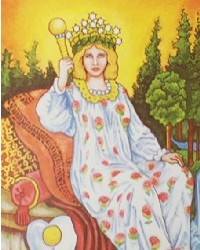
The Tarot card for Aphrodite/Venus, called The Empress, describes her sitting on a luxurious seat, with cushions, in a wooded area, next to a stream, and sometimes a waterfall, which shows her abundance, and connection to the earth:

Here is Irene, on her throne, with cushions, in the woods, next to a stream, and I believe a small waterfall, in the background.
"The astrological symbol for the planet Venus—named for the Roman’s goddess of love, Venus, who was often identified with the Greek Aphrodite—is the same symbol as that used for the biological female: a circle with a small cross beneath (as seen in the above tarot card, on her shield) In alchemy, the Venus symbol also stands for the metal copper, and this provides an interesting link between copper, females and mirrors – in antiquity, polished copper or bronze was used in mirrors. The Venus symbol is also thought to represent the very mirror of Venus or Aphrodite: therefore the connection between Aphrodite and mirrors becomes ever more pronounced...Further symbolism of the mirror shows a connection to secrets...and, as such, to the intense, secret-shattering aspects of light." (At last count, there were at least 5-6 mirrors in Irene's bedroom).

So, let's see here. What secret is Irene hiding behind her Shield Mirror? That's right: Her Heart Phone. "The shield is a paradox...the paradox is that where there is love there is instant protection, yet to love also requires our vulnerabilities." X
Also, don't forget Sherlock's words, before attempting to figure out the safe code: "I really hope you don't have a baby in here."
The Empress tarot is often shown as pregnant, symbolizing that "the situation is pregnant with promise! ( Read Sonnet 59 meta, where Sherlock makes John a promise) - full of opportunity. Along with the symbolism of pregnancy holding promise, comes the waiting period. Just as there is an incubation time until the child comes forth, so too is there a time of waiting until our desires become manifest." So we wait. As Sherlock says, that's what targets do.
"(All) of this links back to the planet Venus, which in Ancient Greece was ruled by two gods, one of which was named Eôsphoros (bringer of dawn) or Phôsphoros (bringer of light); identifying Aphrodite’s sacred planet, Venus, as a bringer of light...The mirror also, in turn, symbolises revelation and truth: the mirror often shows the face, and the eyes, as shown in the painting Venus At Her Mirror by Diego Rodriguez de Silva y Velazquez, in which the goddess gazes into the mirror with only her face revealed."
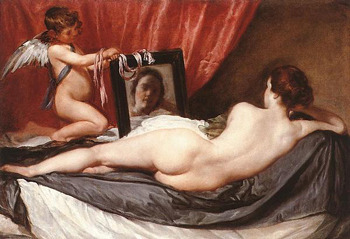
Here, her hair is even similar to Irene's, as are the color found in Irene's home; Red, Black, and White.
"The eyes, in turn, are the paths to truth: they are the “window to the soul”, or, ever-more interestingly, the “mirror of the soul.” Aphrodite, in gazing into the mirror, is therefore not merely enjoying the sight of her own beauty, but is acknowledging the truth of all that resides within her..." X
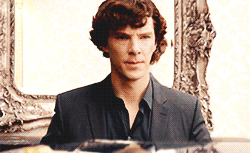
As our story's mirror to Irene, Sherlock appears to go looking for his own truth. If the popular LSIT theory holds true, that The Hiker & the Backfire are indeed about John's failed Romantic getaway with Sarah, it would seem that Sherlock is again, solving multiple mysteries, rolled into one.
The cherry for me in this tale, came from the excellent Art meta by @sagestreet cleopatras-leg-the-sexy-tapestries-in-asib,
"...we get a depiction of the Goddess Aphrodite (Venus) standing behind the couple, her hand outstretched above their heads in benediction. Yes, the Goddess of Love is literally blessing (!) the two lovers just as they’re turning their faces towards each other, about to kiss, absorbed in whatever this little sex game of theirs is.;)"

(OMG...these two. And it HAD to happen within close proximity to Venus.)
But to continue, we get this other bit from Sage's meta: "At the height of the feast, Plutarch tells us, Cleopatra made an entrance dressed as the Goddess Aphrodite, the Goddess of Love." So, in a fun bit of the writers' affinity for inverting, they had Aphrodite Irene, take and dress in Cleopatra Sherlock's clothes....

...here, as she brandishes a phallic symbol, her scepter whip, another Empress motif. She did this, not just once...

...but twice. Irene brought Truth into John and Sherlock's relationship, never swaying from her purpose, even as she played her game of War.

And why not? Venus is known in Ancient times as being the Patron Saint of Homosexual Love between men. Sappho's poetry holds her also as a Saint for Lesbians. X Aphrodite Ourania, the celestial Aphrodite, born from the sea foam after Cronus castrated Uranus...also inspired homosexual male desire or, more specifically, ephebic eros." X "In one context, she is a goddess of prostitutes; in another, she turns the hearts of men and women from sexual vice to virtue." X This could be the possible reason for her chosen profession in Sherlock. She inspires, tempers, and balances, seduces, but more importantly, communicates openly, with her own heart. She knows quite well, the secret wishes made by the hearts of Man. Well...she knows what they like.
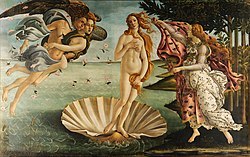
Venus Rising by Sandro Botticelli
Meta inspired, as usual, by a little talk with my friends X . Also, by Planet Narnia: The Seven Heavens in the Imagination of C.S. Lewis by Michael Ward, in which he theorizes that the children in Narnia were each given the personalities of the Seven Ancient Astrological bodies. This book is spotted behind John's chair, in A Study In Pink. The 7th chronical is titled The Final Battle.
@ebaeschnbliah @darlingtonsubstitution @gosherlocked @love-in-mind-palace @loveismyrevolution @kajaono @let-bijohns-be-bi-johns @rominatrix @theragesniff @rinkagaminesstuff @johnnytik @sagestreet @monikakrasnorada @delurkingdetective @221bloodnun @impossibleleaf @tjlcisthenewsexy @devoursjohnlock @roadswewalk @marta-bee @may-shepard @fleurdelisandbees @madzither
#Irene Adler#Aphrodite#Venus#Myth#Astrology#Mythological Intertext#Love#Passion#War#Sappho#Motifs#a scandal in belgravia#C.S. Lewis#Michael Ward#Narnia
58 notes
·
View notes
Text
BBC Sherlock: On Giftedness, Queer Readings, and Fan Labor
This is not about the resolution of a TV show which is currently an open text and may as well continue to be so for the next 20 years.
This is not about predictions or decoding.
This is about intelligent readings and queer subtext and the labor that goes into fans making sense of convoluted narratives in the search for satisfying media and queer representation.
This is about giftedness and queerness and the wages of being different.
(This also got long).
Because if there’s one thing I learned from being part of the BBC Sherlock fandom is that a large number of you, us, fans, are unusually gifted. Whether that giftedness manifests as mental prowess, scholarly achievements, high empathetic IQ, artistic talent or writing virtuosity, we got invested in this show because we all wanted more: more compelling plots, more complex characters, more nuanced queer representation. We wanted more. We wanted something different, different from heteronormative romcoms and linear crime stories. We wanted messy and clever and queer and human. Why wouldn’t we want that? That sounds groundbreaking.
I think it’s no coincidence that we got hooked in a show centered on a protagonist that is coded as gifted, neuro-divergent, and queer. We—so many of us female-identified people—are tired of having the world explained to us by men. And Sherlock, that most human human calculator, seemed miraculously positioned beyond the world of rigid binaries. He appears brilliant but insecure, suicidal and arrogant, interested in humanity but disinterested in heteronormativity. He can be read as trans, a gay man, an asexual, a demiromantic, autistic, bipolar. Different always. Gifted always. Conventional never.
We have been writing this amazing character, you and you and you and you. For years. Your labor gave it life. Your intelligence gave him depth. (The same can be said about John Watson). When canon gave you scraps, you made tapestries. When it gave you gaps, you filled them with intricate designs. You made this show rich and warm and human. You did. You did. With your creative and interpretative labor. By following the clues embedded in a carefully crafted queer subtext. You. Your labor did it. Your giftedness did it. Your desire for different representation, for deeper meaning did it.
Now. We were always in for this ride of humanizing the gifted detective, soften the edges of the broken doctor. With love. (fan love, textual love, queer love, creators’ love) Love, not abuse masquerading as pedagogy. Humanization, not humiliation—fans, girls, people, there’s an abyss of difference between these words.
And that’s it. This is where I draw a harsh line: if you are a gifted/ neuro-divergent/ queer person you probably have been told at some point in life that you need to apologize for your difference, that you need to learn to take what love you can get because you aren’t worth much. That you must labor twice as much to get little back. If on top of that you perceived as a “fangirl” then your labor loses even more value—you only care about sex and schmaltz and “gay men doing it.” Your work of reading texts, of LOVING TEXTS, gets undermined by male creators devaluing your intelligence, your interpretation, your emotional investment.
Well. Fuck that. Please say this with me. Fuck that toxic excuse boys will be boys so violence between them is condoned. Fuck the idea female characters must invariably conform into Victorian models of wifely care-taking and self-sacrifice, EVEN if they are presented as assassins. Fuck the destructive narrative gifted people must be beaten down until they apologize for their capacities, as if betrayal and physical abuse ever made anyone a better human being.
Fuck the notion queer audiences must scrounge for every ounce of subtext and then origami inconsistent narratives into tiny slivers of positive representation because we are SO starved for queer happy endings.
Fuck “fangirls” having to make excuses for male creators’ mistakes, inconsistencies, failures and shortcomings.
And above all, fuck the idea that mass produced and distributed fiction/media should *not* be held to a higher standard than “harmless entertainment”.
Damn it, let’s be real here: we all most likely were saved by fiction at some point in our lives. Books, movies, video games, songs—stories save lives, they make sense of lives. Hell, history has we know it is mostly stories told by victors or people in positions of privileged (beginning with alphabetization).
So damn it, stop letting media (male!) creators off the hook that easily. You stuff your show with queer subtext, you are RESPONSIBLE for it and you are liable to your audiences to address it. You don’t get to keep gaslighting and whiplashing your fans—all your freaking fans at this point— with plot inconsistencies, unaddressed callbacks, and veiled queer references, only to deride them if they refuse to keep laboring for YOU by attempting to make sense of the mess you made of your own show. (You don’t get to call bright fans stupid if they call you out on your muddled writing).
Guess what: Johnlock fans asking for canon queer representation are only following the clues you seeded in your own show. And they deserve better than a contrived plot where gifted queer people only earn love after a beating, or only find their humanity after losing their pride and sense of security.
Or that they can only experience a moment of same-sex intimacy (that long-awaited hug) after said physical contact is followed by discussions on heterosexual courtship behavior (having John’s texts to E being equated with Sherlock’s texts to Irene and both linked with sexual interest). Damn it if that’s not too close to no-homo for my comfort. I don’t want have to write/read 20 posts on subtext to be able to validate a reading of queer romance. I want it to be in PLAIN VIEW, to be TEXT, literal, formalized, spoken, made clear as day, for everybody to see, the same way hetero romance is, every day, all the time!!
Damn it. You know you deserve better when the only way to salvage positive queer representation is to erase the whole narrative in a “it was all a dream” deus-ex-machina scenario (and I love you EMP people, but to me your brilliant and well-researched theory signifies more keenly how intrinsically discontent fans have been with the inconsistencies of canonical narrative since HLV, so much so that some fans had to outsmart the creators and come up with a theory that would actually be clever, if albeit unlikely).
Yes, it’s an open text. You can stick with it or you can walk away. You are not smarter for staying, nor dumb for leaving. You are not an “anti”, nor a fair-weather fan (that’s not a thing, by the way).
Whatever you do remember this (particularly if you are young/alienated/oppressed): your labor is valid. Your emotional investment is valid. Your non-normative readings are valid. You are a fan and you are queer and you are different and you are neuro-atypical and you are pretty damn smart. And for that alone, you always deserve more, better than a queer world designed according to some men’s tipsy-turvy views on what giftedness and same-sex love looks like.
Tagging some people I have been following regarding this: @a-different-equation, @femmelocked, @sweeter-than-cynicism, @ravenmorganleigh, @sussexbound, @wssh-watson, @atikiology (yes you are that person now), @xistentialangst
950 notes
·
View notes
Photo
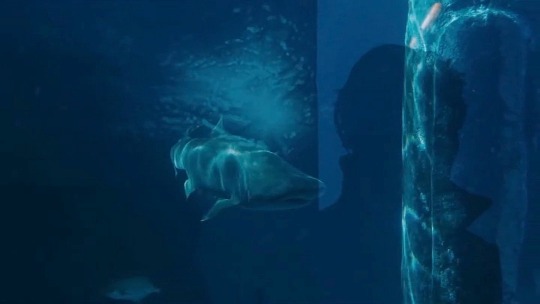
FROM WATER TO WATER ... THE SIX THATCHERS
An attempt to unravel the Sherlock BBC Tapestry based on metaphorical reading
As mentioned in previous posts, this modern Sherlock Holmes adaptation seems to tell the story about the great detective in several cycles. In a very Matroshka-like way one cycle always leads to another. Based on the idea that The Sign of Three serves as the big turning point of the whole story, everything that happens before can be viewed as the basic cycle, the first cycle of the show. The following episodes, His Last Vow and The Abominable Bride, both individually take up certain motives prior to the ‘turning point’ in TSOT, in which Sherlock’s great ‘I’m in love’ revelation happens.
The HLV-cycle (On behalf of AMO) focuses mainly on the ‘twin starting points’ of the story - ASIP&ASIB. The episode spans a bridge between the beginning and end of this modern adaptation as well as the beginning and end of the original canon tales. The following TAB-cycle (From plane to plane) takes Sherlock back to the Victorian Era, the time of Sherlock Holmes’ birth as a literary character. This episode deals first and foremost with the crux of the matter around which Sherlock’s whole case actually revolves. Jim, John and a supernatural monster from hell, represented by hound and bride, are brought right onto centre stage. At the end of this Victorian detour Sherlock willingly dares to face the challenge of the Reichenbach Cauldron - Rich Brook’s Cauldron - Jim’s Cauldron (Pot-Kettle-Cauldron). Baker Street 221b becomes a surreal place where two parallel worlds exist side by side and Sherlock takes up the investigations regarding his ‘pink case’ again in yet another cycle.
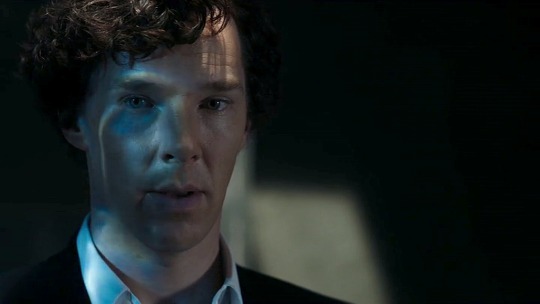
TBC below the cut .....
Series Four of Sherlock BBC consists, as usual, of three parts. It starts with The Six Thatchers, an episode that is significantly placed under the signs of water and change. Once again Sherlock deals with several main themes from previous episodes. Most noticable among them are a turbulent five-part case, very similar to the one in TGG, there are clear Baskerville-Thatcher-Hound connections, a differently revenge/hiatus repetition and Mary’s death in the presence of sharks, that mirrors Sherlock’s from HLV. Those themes aren’t just repeated though, they get changed as well. Rewritten one might say. The motive of ‘rewritten and changed stories’ is even used as introduction for this episode. It starts with the announcement that the shooting at Appledore has been altered as a means to bring Sherlock back to London again ... back into the game. Immediately afterwards, alongside with the opening credits, Sherlock tells his childhood story ‘Appointment in Samarra’ while he walks through the tunnels of the London Aquarium. Later in the episode Mycroft explains that his little brother never liked that particular story and therefore changed it into ‘Appointment in Sumatra’, in which the main character never meets death but survives, becomes a pirate instead and is perfectly fine.
Themes from previous episodes ... repeated and changed:
THE GREAT GAME ... that’s undoubtly the episode from which a great part of the TST structure (five to six) has been taken. More detailed information about the busts and their owners can be found in Who’s a fan of Maggie T? and Batches of six
TGG: Five pips in combination with six bombs connect the cases and two out of six bombs explode.
TST: Five bust owner and six busts connect the cases and all six busts get smashed.
TGG: Sherlock is targeted by Jim the bomber. Revenge seems to be the motive but an actual reason for Jim’s obsession with Sherlock is never given.
TST: Mary is targeted by Ajay the bust smasher. The motive is clearly revenge, although unjustified in Mary’s case, as it turns out later. (A little story in Ypsilons)
TGG: The first bomb explodes, destroyes an empty house and leads to Carl, a boy who had a fit in the water and drowned.
TST: The first smashed bust is linked to an explosion that destroyes a car and leads to Charlie, a boy who had a fit in this car, died and burned.
TGG: The third pip is linked to the only case in which the victiom gets killed by Jim the bomber.
TST: The third bust owner is the only one who gets killed by Ajay the bust smasher.
TGG: Sherlock aims his gun at the last bomb but the explosion is supended because of a phone call.
TST: Sherlock is the one who smashes the last bust and reveals its secret.
TGG: Sherlock, Jim and John meet next to a swimming pool. A memory stick gets thrown into it.
TST: Sherlock and Ajay meet near a swimming pool in Jack’s house (Jack=diminutive of John). A memory stick is found next to it.
THE HOUNDS OF BASKERVILLE ... again the creators of the show play with the double meaning of names/words while the trail of something ‘airborne’ leads to a hound/dog. The smell of the hound
THOB: Margaret Thatcher makes an appearance in the form of six books owned by the facility’s commander (“The Downing Street Years” + one, two, three, four, five separate biographies of Thatcher) and ‘Maggie’ turns out to be the password which provides access to the informations about project HOUND. Sherlock knows exactly who Margaret Thatcher is.
TST: Six Thatcher busts, owned by five people, get smashed. Sherlock doesn’t know anything about Margaret Thatcher nor her profession as PM anymore. Instead the original meaning of the word 'thatcher’ seems to have been moved into focus now ... in the sense of ‘to thatch=to cover’ ... and the busts seem to represent masks/facades that are breaking and crumbling.
THOB: An aerosol triggers the vision of a monstrous hound and affected by it, Sherlock comes face to face with the imagined ‘monster hound’ in Dewer’s Hollow, which is explained as ‘an ancient name for the Devil’.
TST: Sherlock sniffs on a note and affected by the smell, he remembers his lost childhood dog Redbeard and fragments of a melody that will later lead him to Sherrinford, a place that is called a ‘map reference for hell’.
THE REICHENBACH FALL ... it’s always the ‘fall’ and it’s always John and Jim around which the story revolves. And each new version of the ‘fall’ reappears in a new and different setting. (Developement of the fall)
TRF: Sherlock and Jim meet for their great confrontation on Bart’s roof, while John has to watch from the street below. It’s solely a contest of words. Both men successfully talk each other into suicide. Jim shoots himself and Sherlock takes the fall down from the roof to save his friends.
TAB: Sherlock and Jim fight at the edge of the Reichenbach Falls. At first Jim gains the upper hand but then John turns up and with Sherlock’s approval, he kicks Jim over the edge of the waterfall. Then, out of his free will, Sherlock follwos Jim down the Falls. John stays behind.
TST: The joint fall of Sherlock and Ajay into the swimmingpool in Jack’s (John’s) house looks very much like another version of the previous Reichenbach Fall confrontations. This time the famous fight takes place against a background of waves in the shape of snowcapped mountains (swiss alps) and a small artificial waterfall (Reichenbach Falls) that gushes into the swimming pool. The water of the pool seems to boil as in a heated cauldron because of both men’s fierce fighting.
TRF: Sherlock goes undercover to protect his ‘family’ and to confront Jim’s remaining network alone. Only Mycroft and Molly are in on his plan.
TST: Mary goes undercover to protect her new ‘family’ and to confront Ajay alone, who once had been part of her former ‘family’. Unlike Sherlock, she leaves an explaining letter to John.
TRF: By the end of the episode Sherlock and Jim are ‘dead’ because both men commit suicide. Sherlock’s is faked, Jim’s is still an open question. For the rest of the show he exist solely on electronic data, a memory device that seems to resemble brain memory (’You can’t kill an idea, can you? Not once it’s made a home there.’)
TST: By the end of the episode Mary and Ajay are dead as well. Like Sherlock, Mary sacrifices her life for her ‘family’. She gets shot by a character who seems to be linked to Mycroft (Vivian Norbury). Ajay gets shot out of nowhere and without any explanation by some unknown police officer.
TRF: The first Reichenbach solution includes a mask of Sherlock’s face that is used as disguise for Jim. (This is revealed in TEH but thematically it belongs to TRF)
TST: Dr Barnicot’s smashed Thatcher bust covers half of Sherlock’s face like a mask before it starts crumbling down.
THE EMPTY HEARSE ... Sherlock works through the consequences of the fall once more in a different setting. Now Mary, the facade, takes Sherlock’s place. (Mary’s hiatus)
TEH: Sherlock’s hiatus ends somewhere in Serbia, east of GB.
TST: Mary’s hiatus ends in Morocco, west of GB (same longitude as Ireland)
TEH: Sherlock is brought back from hiatus by Mycroft and no one else is informed,
TST: Mary is brought back from hiatus by Sherlock and John. Mycroft is informed and waits for their return in London.
TEH: Sherlock prevents the explosion of a bomb at the forgotten Underground station ‘Sumatra Road’ that would destroy the Houses of Parliament.
TST: Mycroft tells that Sherlock once changed the story ‘Appointment in Samarra’ into ‘Apointment in Sumatra’ and Sherlock is walking on a road now ‘that will become a river with only one destination’.
TEH: The phrase ‘mind the gap’ can be heard linked to the doorbell-sound of train ethusiast Howard Shilcott. He provides the vital clue that reveals the bomber who wants to blow up the Houses of Parliament.
TST: Sherlock notices an ‘ugly gap’ where the first Thatcher bust is missing. This starts the bust-smasher case, which leads not only to Ajay but also unveils a very clever double-agent, who betrayes the government.
HIS LAST VOW ... in parts this episode is already an altered repetition of ASIB. (Strange similarities On behalf of AMO). In an altered version Sherlock is once again confronted with dangerous women.
ASIB: Sherlock is confronted with Irene. She lives an undercover life under a false identity and blackmails the government.
HLV: Sherlock is confronted with Mary. She lives a private life under a false identity at John’s side, while secretly working for the government (stated in TAB).
TST: Sherlock and Mary are confronted with Vivian Norbury. She officially works for the government, while secretly spending her privat life as a double agent, caring for her own profit.
HLV: Sherlock is shot by Mary, who is a cat lover. Sherlock assumes that the gun she used to shoot him is a ‘CAT’ (a brand of that name doesn’t exist).
TST: Mary is shot by Vivian Norbury who is a cat lover and owns three cats.
HLV: The location of the shooting is located high up on the top floor of a London office building with big glass windows and the owner is introduced as ‘shark’.
TST: The location of the shooting is located below ground in the London Aquarium, surrounded by the big glass windows of shark tanks.
ABOUT KILLINGS AND THERAPISTS
A very interesting change happens in TST regarding the characters ‘killed’ by Sherlock in previous episodes.
TRF: Sherlock kills Jim (the bomber) by talking him into suicide.
HLV: Sherlock kills Magnussen in HLV. This incident is oficcially altered by the government in TST. In the new version a nameless ‘squaddie’ with an itchy trigger finger kills Magnussen.
TST: Neither Sherlock nor Mary (his facade), kill Ajay (the bust smasher). Ajay gets shot by a nameless police officer who suddenly turns up out of nowhere (’I’m not a policeman’ says Sherlock in the same episode).
But the most significant change happens regarding Ella Thompson, John’s therapist from the beginning of the story in ASIP.
ASIP: The episode starts with John who awakens from a distressing nightmare of the war in the East and later visits his therapist Ella. She advices him to write a blog about everything that happens to him.
TST: Near the end of the episode it is Sherlock who visits John’s therapist Ella to get her advice about John. In the very next episode it will turn out that Sherlock has taken over John’s blog and a new therapist enters the stage.
The main themes of TST are undoubtedly ‘rewritten and changed stories’ along with a strong ‘water’ connection (emotions). The episode beginns with Sherlock mirrored in the big glass window of a shark tank, reaches its climax in front of the same shark tanks in the London Aquarium and it ends with Sherlock completely surrounded by blue water ... obviously walking a road that becomes a river.
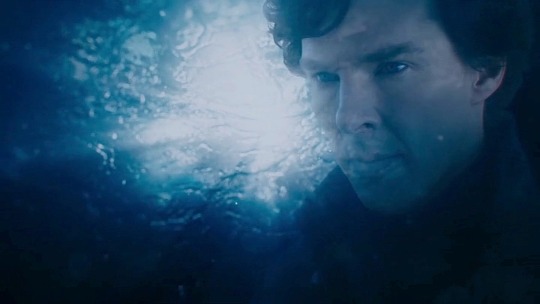
The overall impression of this episode strongly leads to the assumption that Sherlock is - after he followed Jim down the waterfall in TAB - still deeply submerged in the floods of the Reichenbach Cauldron ... Rich Brook’s Cauldron ... Jim’s Cauldron. And the road Sherlock has chosen to walk will again take him back to the very start of the story in ASIP - to John, bad nights, therapists and a talkative serial killer.
From the beginning, then .....
.
Thanks @callie-ariane for the scripts
July, 2022
#sherlock bbc#series four#s4#the six thatchers#tst#from water to water#sherlock bbc tapestry#metaphorical reading
39 notes
·
View notes
Photo

ON BEHALF OF ‘AMO’ … HIS LAST VOW
An attempt to unravel the Sherlock BBC Tapestry based on metaphorical reading
The prior episode The Sign of Three triggered a chain reaction of revelations in Sherlock that led the detective to the quite unexpected realisation that his facade, the guard that ‘thatchend’ and protected his well-kept secret, had been penetrated without noticing. The pink seed of love (Rosie) had been laid and taken root and is now growing slowly but steadily.
‘Oh, what a night! … I was never gonna be the same … I felt a rush like a rollin’ ball of thunder spinnin’ my head around n’ takin’ my body under’
This is the big turning point of the story and also in Sherlock’s investigations regarding his own case, the pink one. Sherlock accepts the change and opts for an entirely different approach to tackle his ‘problem’. Despite being confused, anxious and torn in two, he adds ‘love’ to the equation when he restarts his experiment for another cycle. And so the new client of the new episode turns out to be a character who isn’t only Mycroft’s (brain, reason, intellect) superior, her secret codename, revealed two episodes later, is AMO ... the Latin wording for ‘I love’. AMO comes to Baker Street, asks Sherlock to take her case and retrieve informations about a certain past event, a forbidden almost-love story, that is treated like a dark and scandalous secret ... although nothing that could be called a scandal or a crime has ever really happened.
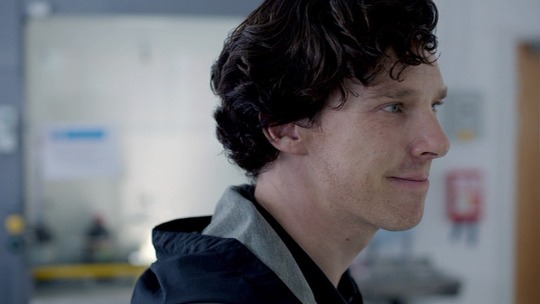
Sherlock takes the case, goes undercover and becomes a junkie who is high on drugs ... the chemistry of love ...
TBC below the cut .....
The title chosen for this episode - His Last Vow - refers to Doyle’s His Last Bow. This story is set in 1914, shortly before the great war breakes loose over the world. It is the very last case the great detective and his best friend and biographer solve together. Holmes’ famous quote about the approaching east wind and good old doctor Watson being the one fixed point in a changing age, marks the endpoint of the Sherlock Holmes canon universe.
'Good old Watson! You are the one fixed point in a changing age. There's an east wind coming all the same, such a wind as never blew on England yet.’
The East Wind is indeed finally released and given free rein in Sherlock BBC ... a ‘wind’ (Eurus) that never blew on ‘England’ (Sherlock) yet. A ‘cleaner, better, stronger land will lie in the sunshine when the storm has cleared’, predicts canon Sherlock Holmes in His Last Bow. And in His Last Vow modern Sherlock Holmes is confronted with an intense war that rages inside himself. One half of his being fights against the other. It’s a war he must loose in order to win. And so His Last Bow marks ‘the end’ while His Last Vow becomes a ‘new beginning’.
The end is the beginning
This theme is repeatedly picked up in Sherlock BBC. The story runs in several cycles that are linked backwards to prior events, either inside this modern adaptation but also in relation to the canon universe. For example:
the penultimate episode, The Lying Detective, takes up the serial-killer-theme from A Study in Pink/PILOT ... that’s a circle backwards to the beginning of the modern Sherlock BBC universe.
the title of the last episode, The Final Problem, is linked to Doyle’s originally planned end of Holmes and Moriarty at the Reichenbach Falls in Switzerland ... that’s a circle backwards to Sherlock BBC’s The Reichenbach Fall
the addition of Victor Trevor and the Musgrave Ritual in the same episode establishes a connection to the literary birth of Sherlock Holmes before he met Dr Watson ... that’s a circle backwards to the chronological beginning of the canon universe.
As mentioned above, the reference to the ‘East Wind’ in His Last Vow, spans a bridge to the canon’s final case, the very last adventure of Sherlock Holmes and Dr Watson. On the other hand, the canon quote about ‘good old Dr Watson’ from His Last Bow, creates a bridge to Sherlock BBC’s first and unofficial episode, the Unaired Pilot, in which Sherlock uses exactly these words when he refers to John Watson, the army doctor whom he had only just met. This in mind, the episode His Last Vow connects the beginning with the end and the end with the beginning and - as far as I see - it is also the episode that uses the method of ‘repeated motives’ for the first time. Assuming that the previous episode, The Sign of Three, is indeed the turning point of the whole story, everything that happened before can be viewed as the first cycle, the basis cycle, of the show.
Sherlock restarts his ‘experiment’ for another cycle
As explained in The meaning of Series One I tend to see the three episodes of Sherlock BBC S1 as Introduction (ASIP), User Manual (TBB) and Chapter List (TGG) for the whole show. The very first chapter of the show, that actually starts the story about Sherlock’s emotional and sexual awakening (in Distraction and Consequences), however, is set in A Scandal in Belgravia. In this episode Irene removes the clerical collar - the ‘dog collar’ - from virgin-Sherlock’s vicar-disguise and confronts him with the ‘scandlous’ naked truth regarding the true nature of his feelings towards his ‘eternal’ best friend. What follows is the ‘rising of the hound’ (sex) because ‘the chemistry of love starts filling the air’ (airosol drug, love is in the air) in THOB. Then Mr Sex reaches for the crown jewels to rule the whole empire (body) in TRF. Sherlock retreats (hiatus) but then he returns and starts to investigate and question his facade (Mary) in TEH and tries to assess what might happen if he isn’t able to prevent the explosion (love confession). Because ‘once you’ve opened your heart, you can’t close it again ... you can’t take it back’. Finally - Hamish - John’s secret and unliked middle name (the Scottish version of James/Jim) leads Sherlock to the big ‘I’m in love’ revelation in TSOT. It is ‘Mr Sex’ who hides in plain sight, right in the middle of John H Watson. This becomes the great turning point of the story and the following episode - His Last Vow - marks a new beginning. AMO (I love) asks Sherlock to retrieve some ‘sensitive and dangerous information’, kept somewhere deep inside the vaults of the ‘Alexandrian Library of secrets and scandals’ ... a place deep inside Sherlock’s own mind palace where he keeps all the thoughts, ideas and fantasies he is most afraid of and never wanted - never was allowed - to deal with.
How big of a surprise is it then that the motives Sherlock picks up in this first repetition are, above all, from those episodes that can also be viewed as the two ‘starting points’ of Sherlock BBC ... ASIP and ASIB ... because they come ‘always in pairs’. :)
ASIB revisited in HLV
The consideralbe amount of interesting connections between HLV and 'Scandal’ have been already the subject of several discussions back in 2016. It’s all a bit of a blur by Longsnowsmoon5 triggered what I called ‘Strange Similarities’. Here’s a summary and comparison of the most striking interconnections between those two episodes:
ASIB: Sherlock wakes up (in 221b), covered in nothing but a white sheet.
HLV: Sherlock wakes up (in a morgue), covered in nothing but a white sheet.
ASIB: Mycroft, the government (brain), orders Sherlock to find and retrieve a phone with informations about a scandalous secret.
HLV: Lady Smallwood, Mycroft’s superior (AMO), orders Sherlock to find and retrieve a letter with informations about a scandalous secret.
ASIB: Mycroft takes his order back and tells Sherlock: “The 'secrets owner’ is no longer any concern of yours. From now on you will stay out of this.” Sherlock doesn’t obey.
HLV: Mycroft interferes with the Smallwood case and tells Sherlock: “The 'secrets owner’ is not your business. If you go against (that person), then you will find yourself going against me”. Sherlock doesn’t obey.
ASIB: Sherlock disguises as vicar, engaged with god (himself), before he contacts the person who owns the secret.
HLV: Sherlock disguises as junkie, engagend with Janine (’little’ John), before he contacts the person who owns the secret.
ASIB: Secrets and scandals on Irene’s phone ... ‘On this phone I’ve got secrets, pictures and scandals that could topple your whole world’.
HLV: Secrets and scandals inside Magnussens’s vaults ... underneath that house there is kept ‘the greatest repository of sensitive and dangerous information anywhere in the world, the Alexandrian Library of secrets and scandals’.
ASIB: Sherlock isn’t the only one who tries to retrieve scandalous informations. CIA agents (’Mycroft is the CIA on a freelance basis’ ASIP) are also after those informations.
HLV: Sherlock isn’t the only one who tries to retrieve scandalous informations. Mary (’Little brother must never suspect you of working for me’ says Mycroft in TAB) is also after informations kept at the same place.
ASIB: Neither Sherlock nor the CIA agents are able to retrieve the scandalous informations. Instead Sherlock gets drugged and beaten because of that case and ultimately ends up unconscious in bed ... DI Lestrade takes a video of drugged Sherlock.
HLV: Neither Sherlock nor Mary are able to retrieve the scandalous informations. Instead Sherlock, who got high for that case, gets beaten and shot and ultimately ends up unconscious in bed ... DI Lestrade wants to take a video of drugged Sherlock.
ASIB: Sherlock is attacked by a woman (Irene) who has a dubious past, misbehaves, is used to live an undercover life with a fake identity ... and yet, Sherlock protects her anyway.
HLV: Sherlock is attacked by a woman (Mary) who has a dubious past, misbehaves, is used to live an undercover life with a fake identity ... and yet, he protects her anyway.
ASIB: Irene’s PA and friend is called Kate. Kate takes John to an abandoned building - a disused power station - where he is confronted with the truth about his relationship with Sherlock.
HLV: Mary’s neighbour and friend is called Kate. Kate sends John to an abandoned building - a drug den - where he is confronted with Sherlock who is high for a case.
ASIB: Ordered by Mycroft and in agreement with John, 221b Baker Street is searched for drugs.
HLV: Ordered by Mycroft and in agreement with John, 221b Baker Street is searched for drugs.
ASIB: CIA agent Neilson, who is connected to Mycroft, orders his men to search Sherlock and John for secret weapons.
HLV: Magnussen, who is connected to Mycroft, orders his bodyguards to search Sherlock and John for secret weapons.
ASIB: A time jump of several months happens ... then it is Christmas.
HLV: A time jump of several months happens ... then it is Christmas.
ASIB: A person (Irene) lies ‘dead’ in the morgue - Molly, Mycrofft and Sherlock are surrounding her body. Later Irene comes back from the dead.
HLV: A person (Sherlock) lies ‘dead’ in the morgue - Molly, Mycrofft and Sherlock are surrounding his body (inside the MP). Later Sherlock comes back from the dead.
ASIB: Sherlock says ‘People don’t really go to heaven when they die. They’re taken to a special room and burned.’
HLV: John says ‘Alarms would go off and you’d be dragged away by security and taken to a small room somewhere and your head kicked in.’
ASIB: At some point Sherlock gets really angry and throws a man, who is connected to Mycroft and tortured Mrs Hudson, out of the window.
HLV: At some point Sherlock gets really angry and shoots a man, who is connected to Mycroft and tortured John, in the head.
ASIB: Irene isn’t expected to survive undercover more than six months without her protection.
HLV: Sherlock’s undercover assignment is expected to prove fatal within six months.
ASIB: Jim sends a message to ‘the government’ and a flight (of the dead) gets cancelled.
HLV: Jim sends a message to ‘the whole country’ and a flight (into death) gets cancelled.
ASIB: Beyond the black screen of the END credits - static interferences initiate one additional and not expected information ... Irene is still alive.
HLV: Beyond the black screen of the END credits - static interferences initiate one additional and not expected information ... Jim appears to be still alive.
ASIP revisited in HLV
For a long time I wasn’t aware that ASIB isn’t the only ‘first’ episode that is mirrored in HLV ... not until this post by @critgemhero crossed my dash. Fascinating how the creators of Sherlock BBC are able to hide informations in plain sight throughout their show. The amount of connecting points between those two episodes is just as considerable as the ones between ASIB and HLV. Here’s a summary and comparison of the most striking similarities (extended by some of my own observations):
ASIP: John wakes from an Afghanistan nightmare.
HLV: John wakes from an Afghanistan nightmare.
ASIP: Sherlock admits having been a junkie.
HLV: Sherlock is forced to admit that he’s taken drugs for the case.
ASIP: Anderson assists DI Lestrade with a drugs bust at 221b.
HLV: Anderson assists Mycroft with a drugs bust at 221b.
ASIP: The Lauriston Garden staircase and the hallway of Roland-Kerr Further Education College are important locations in ASIP.
HLV: The Lauriston Garden staircase and the hallway of Roland-Kerr Further Education College turn up again and play an important role inside Sherlock’s mind palace.
ASIP: Sherlock thinks 'Oh, it’s Christmas!’ because of the new case and Mycroft’s negative attitude towards Christmas dinners is mentioned.
HLV: It is Christmas and Mycroft’s negative attitude towards Christmas dinners can be observed.
ASIP: Sherlock characterizes himself as sociopath ‘I’m not a psychopath, Anderson. I’m a high-functioning sociopath. Do your research.’
HLV: Sherlock characterizes himself as sociopath ‘I’m a high-functioning sociopath. Merry Christmas!’
ASIP: John shoots Hope to protect Sherlock.
HLV: Sherlock shoots CAM to protect John and Mary.
ASIP: Sherlock’s and John’s first meeting and first handshake.
HLV: Sherlock’s and John’s farewell and a last handshake.
ASIP: A barking dog can be heard after John has waken from his nightmare.
HLV: Redbeard, Sherlock’s childhood dog enters the stage for the first time.
ASIP: The junior minister for transport becomes a victim of Hope.
HLV: The empty houses at Leinster Gardens are described as fake facade for transport.
ASIP: John eats pasta that could be penne at Angelo’s Italian restaurant.
HLV: Sherlock eats pasta penne at a restaurant he calls the ‘hospital canteen’. (Pasta Penne)
ASIP: Two phone calls - Sherlock instructs John to come to Baker Street 221b and Hope to Northumberland Street 22.
HLV: Two phone calls - Sherlock seperately instructs John and Mary to come to the empty houses at 23 and 24 Leinster Gardens. (21,22,23,24 ... interesting)
ASIP: Twin houses - Roland-Kerr Further Education College.
HLV: Twin houses - Leinster Gardens 23&24.
ASIP: Empty houses - the crime scene location at Lauriston Gardens and Roland-Kerr Further Education College (’only the cleaners are in’).
HLV: Empty houses - the derelict drug den in which Sherlock is high for a case (’Is he clean?’ ... ‘Clean?’) and the twin houses at Leinster Gardens.
ASIP: A pink case lies in a garbage container that’s called a skip.
HLV: Sherlock (he IS the pink case) lies in a drug den that’s called a dump.
ASIP: Sherlock beats a dead body in a morgue who is covered by a white sheet.
HLV: Sherlock gets beaten and becomes a dead body in a morgue, covered by a white sheet.
ASIP: Jim Moriarty enters the stage for the first time at the end of the episode.
HLV: Jim Moriarty re-enters the stage at the end of the episode.
What does actually happen in HLV
Sherlock takes the case of AMO and gets high on drugs.
Mycroft orders him to stay out of that case but Sherlock doesn’t obey.
Sherlock pretends to be in love with Janine and even gets engaged with her to get access to the secret informations regarding AMO.
He fails to get the information but finds Mary instead, who just like him, tries to get access to secret informations about herself but fails as well.
The secrets of both characters - Lady Elizabeth Smallwood and Mary Elizabeth Watson - are kept at Magnussen’s Appledore. (same middle names ... ineresting)
Mary shoots Sherlock to keep her secret hidden but Sherlock survives.
John gets informed and stays with Mary.
Mycroft recommends that Sherlock should decline an MI6 undercover assignment in Eastern Europe that would prove fatal for him in about six months.
AMO’s secret is made public and a man commits suicide.
Mary’s secret stays hidden because a man gets killed. Sherlock too is expected to die because due to Mycroft’s suggestion and AMO’s approval he has to go on the previously declined suicide mission.
When Sherlock’s plane takes off eastwards, Jim Moriarty turns up simultaneously on every screen in the country and the flight gets cancled.
Mycroft thinks that Sherlock was already high on drugs even before he entered the plane.
Mirrored shootings ...
John shoots Hope, Mary shoots Sherlock, Sherlock shoots Magnussen, Norbury shoots Mary, Eurus shoots John and Jim shoots himself ... twice. Imagine that all those shooting scenes miraculously condense and merge into just one moment in time ... what a highly dramatic Mexican standoff that would be. :)
The ‘dual’ shooting of Sherlock in HLV and Mary in TST has been a subject for many discussions and theories in the past, because both ‘death scenes’ have been clearly designed as opposite mirrors. Even the placements of their gunshot wounds are identical. It’s really very hard to assume that those scenes could have come to pass by some strange coincidence.
In HLV Mary shoots Sherlock at CAM Tower, in Magnussen’s penthouse high up over the roofs of London, surrounded by massive glass windows. Magnussen is compared to a ‘shark’ by Sherlock.
Mary’s death-scene in TST happens deep down, in the underground passageways of the London Aquarium, surrounded by the massive glass windows of shark and jellyfish tanks.
About shootings and explosions ....
In the additions of this post by @possiblyimbiassed I wrote about some ideas and possible explanations (on a metaphorical level) regarding the chronological sequence of those shootings in connection with the exploding bombs that hit 221b Baker Street in TGG and TFP.
Mary gets outed as facade in HLV - Sherlock’s facade - because her picture covers the front of the Empty Houses, which are confirmed to be Sherlock’s property. It’s not uncommon to use ‘house’ as a metaphor for ‘body’ (@gosherlocked refered to that topic in Set this house of fire). These considerations in mind, wouldn’t it make sense, to assume that a bullet, fired at a house (body) covered by a facade, would cause a hole in both - the facade and the house - at the same spot? Sure, there is the fact that in the timeline of this story the body (Sherlock) is hit earlier than the facade (Mary) - which is impossible in a real life situation - but on the other hand … do we assume this to be a real life situation? If that shot and the resulting wound are metaphors and meant to be a consequence of Sherlock’s earlier ‘I’m in love’ deduction in TSOT, then the basic conditions might be different because Sherlock’s realisation happens in the mind - inside his body - and therefore the shot, the explosion would go from the inside out, right? It would hit first the body and then the facade.
The two explosions in 221b Baker Street come to mind. The one in TGG happens outside but the one in TFP takes place inside the house (The symbolism of exploding bombs). What’s even more interesting, the outside explosion in TGG happens in the house opposite 221b, exactly where ‘the empty house’ from canon is located. And the one responsible for the explosion is Jim - Mr Sex - who invites/tempts Sherlock to play the game with him. Also interesting, PILOT-John hides in that house opposite, shoots at 221b and the glass window breaks. A possible interpretation could be: first something ‘explosively sexy’ (John) hits a house/a body (Sherlock’s) from outside (like: the first time ever I saw your face) and as a result it triggers a revelation, an explosion inside the mind, that ultimately smashes the facade (Mary) to pieces.
Metaphorical interpretation
In HLV Sherlock - due to his ‘I’m in love’ revelation from TSOT - seems to fight with himself. To get access to a scandalous information about a forbidden love affair that never came to pass, he pretends to be in love with Janine. Her name is a female version of John, meaning ‘little John’. As a consequence, Sherlock is confronted with his own fassade, represented by Mary, who guards his own deepest secret - that he is in love with John. He is torn between the desire to reveal his secret and his fear to endanger the ‘eternal’ friendship with John and lose him forever, if he dares to tell the truth. Because, as Culverton Smith says: ‘If you tell them your darkest secret and they decide they’d rather not know, you can’t take it back. You can’t unsay it. Once you’ve opened your heart, you can’t close it again.’ This inner confrontation becomes the centerpiece of the episode.
‘John or James Watson? Saint or Sinner? James or John? The more is Less?’ (TEH)
So, if Sherlock wants more - not just John’s friendship but also his love - he might have less in the end. That’s the risk. One half of his being is at war with the ‘other one’. The part of him that is still covered and protected by the facade, stands opposed to Sherlock’s slowly increasing emotional side, that is driven by his love for John. Somewhere deep inside his mind Sherlock probably knows already that this is ‘a war he must lose’. To solve this case though, he first has to go deeper inside himself. Suggested by Mycroft and with AMO’s approval, Sherlock is sent on an undercover assignment into that part of the world where the ‘East Wind’ (Eurus) comes from. The plane takes off but it has hardly gained some height, when Mycroft (brain) receives the message that Jim (Mr Sex) suddenly has turned up on every screen in the country (in every fibre of Sherlock’s body). Although the mission immediately gets cancled - because Sherlock always reacts to ‘John is in danger’ - it seems to be already too late for another retreat, similar to the one that followed the Reichenbach Fall. It looks like Sherlock has crossed the Rubikon for good and the road he’s walking/flying now, has already become ‘a river with only one destination’.
In any case, it’s not quite clear where Sherlock has been left in this story. Has the plane really landed again? If so, where did it land? Or is it still flying? None of the following episodes provides a clear answer to that conundrum.
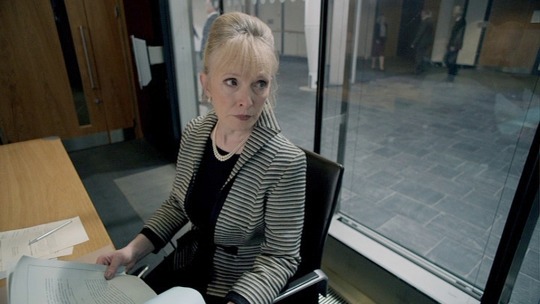
Metaphorical reading of: The Sign of Three The Hamish Investigation
Thanks for reading and thanks @callie-ariane for the scripts.
May, 2022
34 notes
·
View notes
Photo

FROM THERAPIST TO THERAPIST ... THE LYING DETECTIVE
An attempt to unravel the Sherlock BBC Tapestry based on metaphorical reading
The second episode of Sherlock BBCs fourth series continues with the Matroshka-like cycles that dominate the story since the great ‘turning point’ in TSOT, started by Sherlock’s ‘I’m in love’ revelation. From that moment onwards Sherlock repeatedly picks up events from previous episodes to investigate and evaluate them under a new perspective. In HLV he adds the AMO-aspect, in TAB he returns to his literary roots in the Victorian Era and finally dares to throw himself down into Rich Brook’s Cauldron of boiling emotions. TST brings Sherlock back to yet another beginning. He focuses now on motives from the Great Game, the Hound, the Fall, Hiatus and Return ... until all of this culminates in an altered version of HLV (which is already a repetition of ASIB ‘On behalf of AMO’). The Six Thatchers is significantly placed under the signs of water and change (From water to water). At the end Sherlock visits Ella Thompson, initially John’s therapist, introduced at the very beginning of the story. Sherlock seeks her advice regarding John Watson and then he continues the ‘watery’ road that will become a river with only one destination.
In The Lying Detective Sherlock starts another cycle that brings him once again back to another beginning. And just like the previous episodes, this one is also heavily placed under the sign of change. Above all, Sherlock reflects now on the very first case he investigated together with his - at the time - new acquaintance, the intriguing army doctor John Watson. And thus, the story told in Sherlock BBC draws a full circle backwards to its beginning in ASIP. Bad nights, a therapist, a talkative serial killer and first and foremost John Watson are once again moved into the spotlight. Quite similar to ASIP and PILOT the audience makes the acquaintance of John’s therapist, although the doctor’s bad nights have a different reason now and his therapist has changed as well. Ella Thopson - a rather changeable character herself, regarding office and outfit, gets replaced by another female therapist called Elsa/Elizabeth. Her surname is never mentioned. And a different, although quite familiar serial killer catches the attention of Sherlock Holmes. Meanwhile the great detective has changed as well. The former junkie, ‘who doesn’t even smoke’ in ASIP has turned into a permanent addict, who’s almost constantly high and on the verge of dying.

Eurus - the much feared East Wind of Change - out of big brother’s ghost story from Sherlock’s childhood, has come very close now and is aiming the focus (the gun) precisely at John Watson .....
TBC below the cut .....
Themes from previous episodes ... repeated and changed:
A STUDY IN PINK ... it’s undoubtly the serial-killer-theme from Sherlock’s and John’s first case that dominates also the main story in The Lying Detective. A detailed comparison can be found in Serial Killer Connections and Saving John Watson
ASIP: John is haunted by nightmares from his military service in Afghanistan.
TLD: John’s nights are haunted by memories of Mary’s death.
ASIP: Sherlock mistakes the gender of John’s sibling. The male name ‘Harry’ belongs to John’s sister. So far, she has never appeared on screen.
TLD: John mistakes the gender of Sherlock’s sibling. The male name ‘Eurus’ (god of the east wind) belongs to Sherlock’s sister. She appears on screen incognito in TST and reveals herself by the end of TLD.
ASIP: Sherlock is portrayed as former junkie, who is clean now and doesn’t even smoke but uses nicotine patches.
TLD: Sherlock is ‘off his tits on drugs’ through almost the entirety of the episode.
ASIP: The main case is about the talkative serial killer Jeff HOPE. He is a father of two children, boy and girl.
TLD: The main case is about the talkative serial killer Culverten Smith. He is the father of a daughter called FAITH, who has a double appearance in the story, played by two different actresses.
PILOT: Serial killer Jeff Hope refers to possible victims as ‘anyone’ two times.
ASIP: Serial killer Jeff Hope never uses the word ‘anyone’ at all.
TLD: The word ‘anyone’ regarding the victims of serial killer Culverton Smith is uttered 28 times by himself and other characters.
ASIP: ‘What happened at Lauriston Gardens? I must have blacked out.’ ... is part of Sherlock’s text message at serial killer Jeff Hope, typed out by John in 221b.
TLD: The painting of Mr Blue Skull appears to be completely blacked out in the scene where Mycroft and his agents are thrown out of 221b by Mrs Hudson so that John can watch Mary’s note privately. At the same time Sherlock awakens in hospital in the presence of serial killer Culverton Smith.
ASIP: Hope forces his victims to play a game of good pill-bad pill with him. If they choose the wrong pill (chemistry), they die of suffocation.
TLD: Smith first overdoses his victims with hospital medication (chemistry), then he suffocoats them with his own hands.
ASIP: John shoots Hope from a distance before killer and victim are able to take their chosen pills. Hope dies.
TLD: John overpowers Smith before the killer is able to suffocate his victim. Smith goes to prison.
ASIP: John Watson is portrayed very differently in the unaired PILOT compared with his character throughout the whole of the official series. PILOT-John is a very nice person, official-John not so much. (X X X).
TLD: The serial killer’s daughter, Faith Smith, is portrayed by two different actresses who don’t seem to impersonate the same character type. Both are mirrors for John. One is a very nice person, the other one not so much.
PILOT: John shoots Hope and then throws his gun into the Thames.
ASIP: John shoots Hope and keeps his gun.
TLD: The gun Faith carries in her handbag, apparently to shoot herself, appears to be of the same brand as John’s gun. Sherlock throws Faith’s gun into the Thames and in the millisecond-flashback-clip that follows this scene, the muzzle of John’s gun can be seen. (Eddie Van Coon from TBB and Major James Sholto from TSOT own the same gun) Bottom of the Thames
Also included in The Lying Detective are links to the cases of the Woman, the Hound and the Fall:
ASIB: After the incident with the CIA agents, who try to retrieve Irene Adler’s camera phone but fail because of Mrs Hudson’s uncooperativeness, Sherlock announces that ‘England would fall’ if Mrs Hudson ever leaves Baker Street (Am I the current king of England?).
TLD: Mrs Hudson actually leaves Baker Street and takes Sherlock, who lies drugged in the boot of her car, which is financed by drug-money, to John’s new therapist Elsa/Elizabeth/Eurus.
ASIB: Irene Adler sends Sherlock a text message on New Year’s Eve, a day that is closely connected to fireworks.
TLD: Irene sends Sherlock a text message, while Sherlock is holding and drinking from a mug painted with fireworks.
THOB: A drug - the H.O.U.N.D. aerosol - plays an important role in the episode. This stimulant had been created by five people and was further developed by Dr Frankland (which makes a total of six people). It renders its users incredibly suggestible to paranoia, fear and terror.
TLD: A drug - TD12 - plays an important role in the episode. The memory inhibitor had been created by Dr Ivan’s (John’s) company and is used by Culverton Smith on a group of six people (including Dr Ivan and Faith) in order to confess his darkest secrets, that will be forgotten immediately afterwards.
TRF: Jim uses a fire extinguisher to break open the glass cabinet that contains the crown jewels. It’s the prelude to a string of events that will lead to Sherlock’s fall from Bart’s roof. The fire extinguisher goes into action before the fall.
TLD: John uses a fire extinguisher to break open the door to Sherlock’s hospital room in order to stop the serial killer and save Sherlock’s life. This scene is set after the morgue scene, which appears to be yet another variation of the Reichenbach Fall. The fire extinguisher goes into action after this altered version of the fall.
TRF: The first Reichenbach solution includes blue contact lenses to disguise the brown colour of Jim’s eyes. (This is only revealed in TEH but thematically it belongs to TRF)
TLD: When Eurus reveals her true identity, she first removes a brown contact lense from her actually blue eyes.
HIS LAST VOW ... blood-carpets and more guns
HLV: A blood-red carpet, shaped like a pool of blood, is among Magnussen’s office equipment.
TLD: The same blood-carpent appears among the office equipment of John’s new therapist Elsa/Elizabeth/Eurus.
HLV: The gun Mary uses to shoot Sherlock is a Walther PPK, equipped with a silencer.
TST: The gun Vivian Norbury aims at Sherlock and hits Mary instead, is a Walther PPK.
TLD: The ‘smoking gun’ at the beginning and the end of the episode and during one of the two flashbacks on the Hungerford Bridge, is also a Walther PPK (the other flashback shows John’s gun). (The smoking gun: 1 2 3)
As mentioned above, the concept of ‘changed and rewritten stories’ clearly continues in TLD the same way it does in TST. This time though the main focus lies heavily on the two slightly different starting points of Sherlock BBC ... A Study in Pink and the unaired PILOT.
A case of two Faiths
Another interesting feature of interest is the double presence of Faith Smith. Her character is even portrayed by two different actresses. Faith1 visits Sherlock at Baker Street and asks him to take her case. Faith2 joins her father Culverton Smith at the morgue, claiming that she never visited Baker Street. The limp and the cane connect both women to John but only one of the dissimilar ‘not-twins’ - the nice one - makes a closer acquaintance with Sherlock, which mirrors his first meeting with John in PILOT and ASIP. Only by the end of the episode it becomes clear that precisely this incarnation of Faith had indeed visited Baker Street and wasn’t just a drug induced (love induced) fantasy of the detective. Sherlock finds her note there and illuminated by ultraviolett light the words ‘Miss Me?’ become visible. At the same time the therapist reveals her identity towards John in a way that connects her closely to Jim Moriarty. She removes a contact lense and shows the true colour of her eyes. Then Eurus, Sherlock’s secret sister, shoots John with a gun that is definitely not the ‘smoking gun’, that can be seen at the beginning and the end of the episode. Eurus’ gun has much more resemblance with the gun in Faith’s handbag, the one Sherlock throws into the Thames on the Hungerford Bridge.

Musgrave and a case of two John’s
The introduction of these exceptional ‘twin mirrors’ for John Watson encourages the assumption that 'the good doctor’ might be also represented by two dissimilar character twins. Comparing John’s character from the Unaired Pilot with John Watson from the official story, one could indeed come to the conclusion that something like this might not be entirely impossible. Even outside the story - on the stamps released for the 10th anniversary of the show - this duality of the John-character has been taken into account by the usage of joined visuals from both episodes, ASIP and TLD (Anatomy of a stamp-Double John). There’s generally an undeniable 'sign of two’ attached to the whole show. The cyphers for a secret code always come in pairs. It’s twins and yet, it’s never twins. There are dissimilar canines (dog&hound) and dissimilar felines (cat&lion). Two times twin houses play an important role. And a lot more examples of that kind can be found throughout the story. (Pairs, twins, double oh’s They come in pairs Double oh seven, Bond Air)
There are also two short scenes in S1 that can be interpreted in a very interesting way. The first takes place right at the beginning of ASIP, when Mike Stamford accidently meets John Watson. “That’s not the John Watson I know.” Mike says and John answers: “Yeah, I’m not the John Watson.” Is this dialogue meant to be taken verbatim? The second scene happens near the end of TGG at the swimming pool. For a short moment Sherlock mistakes John for Jim. Is this another hint that THIS John Watson is maybe not THE John Watson the audience expects and is accustomed to see? And this conspicious ‘sign of two’ can also be applied to the (currently) last episode of the show. In The Final Problem the Musgrave Ritual turns out to be the solution of the case. In canon this ritual/riddle is about a royal crown and two kings named Charles:
Whose was it? ... His who is gone.
Who shall have it? ... He who will come.
Two characters with variations of the same name are also involved in Sherlock BBC, in which they play important roles. Carl Powers, whose mysteriously disappeared shoes start the great game between Jim and Sherlock and Charlie Welsborough, whose mysterious disappearance marks the beginning of the bust-smasher case. Both cases - the exploding bombs in S1 and the smashed busts in S4 - are clearly linked to each other. That makes two Faiths and two Charles who play significant roles in this story. While both Faiths are designed as mirrors for John, both Charles seem to represent Sherlock. Coincidence or lazy universe?
But why would two Johns be needed in this adaptation? The first reason that comes to mind is to point out a certain contrast. And there is definitely a difference between PILOT-John and OFFICIAL-John. There’s also a noticable and opposed character developement regarding John and Sherlock. The more vulnerable, soft, emotional and human Sherlock becomes in the course of the story, the more angrier, insensitive and rough John seems to grow. Until his behaviour - completely unusual for a portrayal of Dr Watson - culminates in the truely abominable morgue scene in TLD, in which he beats up his ill and helpless best friend, who doesn’t even defend himself. John slams his fists, hits Sherlock hard and brutal, until he bleeds. Even as Sherlock goes to the ground, John still continues kicking with his feet until some people forcefully pull him away. Never in the history of Sherlock Holmes adaptations has the good doctor been portrayed in such a repelling way. This feels like the decostruction of Dr Watson’s character.
The eternal best friend for more than a century
If one takes a critical glance at OFFICIAL-John, it is impossible to overlook that he displays a very distanced and often annoyed attitude towards any assumption that his relationship with Sherlock could be viewed as more than just friendship. This behaviour can be noticed from the first series onwards - when he corrects Sherlock’s introducing words ‘my friend’ to ‘colleague’ in TBB and it increases the further the story expands. At the beginning OFFICIAL-John lives up to his canon reputation of being a ‘ladie’s man’ quite thoroughly, when he changes his girl friends in a quick row. In the canon story The Sign of Four Dr Watson calls himself ‘three continets Watson’. This refers to his ‘experience of women which extends over many nations and three separate continents’. At the time when OFFICIAL-John’s potential girl friends stop to appear ‘on stage’ his patronising behaviour towards Sherlock starts to increase noticable. He advices Sherlock to be more careful because people might talk and every time someone assumes a relationship of romantic nature between himself and the detective, John acts clearly not amused. Then he marries Mary, never notices Sherlock’s pain because of it and even jokes about his dancing lessions with Sherlock behind closed curtains in a very insensitive way. The doctor threatens to beat Sherlock although his friend is seriously wounded. He forgives Mary and stays with his wife although she was the one who shot Sherlock. He doesn’t prevent Sherlock from killing Magnussen although he could have done it (X) and he accepts Sherlock’s exile sentence without any protest. He threatens Sherlock a second time to ‘break every bone in his body while naming them, if he doesn’t hold himself to a higher standard’. He even blames Sherlock for Mary’s death, cancels their friendship and lets him know that he’d rather have anyone but Sherlock. Finally John makes his prior threats come true and beats Sherlock up so badly that his ‘former best friend’ has to be hospitalized. And absolutely inconceivable ... John never even apologizes for his outrageous behaviour, not even when Sherlock takes him in his arms to console him. That’s quite a long list of more than questionable behaviour, a behaviour that can easily be labled as homophobic. The way OFFICIAL-John is portrayed in this regard surpasses Mary’s actions any time. I’m well aware that considering John Watson as possible candidate for the role of ‘Mr Homophobia’ in this story must feel like a sacrilege. It seems downright inconceivable and impossible. And yet, the evidence that this could be the case after all, is considerable. Which reminds me of the famous Holmes quote from canon - and Mycroft’s online advice in PILOT - ‘when you have eliminated the impossible whatever remains must be the truth’ …. however improbable it may seem. Well ....
All of this inevitably rises the question of ‘WHY’. Why have the creators decided to do this to the good and always loyal Dr Watson? What might be the reason behind the decision to cast such a dark shadow especially on this man? Of course, one can only assume and speculate ... which leads to another still unanswered question ... who might be the real antagonist of this story? Because the list of possible ‘big villains’ has grown a bit thin by now. Officially Jim Moriarty is still dead. All his appearances since his suicide at the end of TRF are limited to DVD recordings. Magnussen has been killed by Sherlock himself. The abominable bride and faithfull sister, who turned into ghost sister Eurus, is again locked up in Sherrinford. Mary is dead and seems to share Jim’s fate regarding the DVD recordings. Culverton Smith, the loudly announced big baddie of S4, is in prison. This could leave big brother Mycroft for that role and that would be entirely possible, especially because he is suspiciously absent at the end of TFP. But would it also come as a big surprise and devastating rug-pull, as the showrunners have often announced? Probably not. ‘A villain who comes slamming right into the center’ ... that was the official description for Sherlock’s new and dangerous opponent in S4. But can those words really relate to Mary, Eurus, Jim, Mycroft or even Culverton Smith? The word ‘slamming’ is a bit of an odd choice. It doesn’t really fit with any of those characters. The most obvious candidate - Smith - is much more a talker than a slammer, I would say. Actually, there’s only one character in this episode whose actions can be described as ‘slamming right into the centre’ ... sadly that’s John Watson. Maybe it is indeed a bit hasty to rule out the good doctor - Sherlock’s best and most trustworthy ‘eternal’ friend for more than a century - as possible candidate for the big villain. One thing, in any case, is sure - John Watson has definitely the biggest potential for the perfect antagonist and for the most surprising and devastating rug-pull ever.
That’s a good moment to remember the theory of ‘the case of the two Johns’ and the unaired PILOT in which John as well as Sherlock stand in sharp contrast to their character mirrors in the official broadcasted series. Strictly speaking, the entire PILOT looks and feels quite different regarding cinematography, sets, visuals, colours, music and not to forget, most of the PILOT has been filmed mirror-inverted. Not without reason is this inofficial episode often called ‘the gay pilot’. Maybe both versions have been created with purpose after all. They could offer the audience a clear comparison between two relationship variations regarding Holmes and Watson … the century old eternal friendship on the one hand and a gay love story on the other. Maybe OFFICIAL-John really represents not just Sherlock’s traditional, conservative ‘eternal friend’ - good old Dr Watson - but also Sherlock’s supressed and desperately unspoken desire for his best friend, a desire that almost kills him. This could be a possible reason for the unusual, negative representation of Dr Watson’s character in this adaptation and especially in this episode. The ‘good doctor’ needs to be changed and replaced with a different John, a new and vibrant version of that character, someone who is able to become more than just Sherlock’s best friend, so that both men are finally able to live in a modern gay relationship. At least, that’s what I (still) hope for and this - the case of two Johns - is my interpretation of the unusual character changes regarding Dr Watson.
King John is dead! And the crown - for a long time guarded by the Musgrave Ritual/Riddle - is now ready for a new bearer. Long live king John!
(Similar ideas in the additions on this post)
Thanks for reading that far and thanks @callie-ariane for the scripts
July, 2022
#sherlock bbc#series four#s4#the lying detective#tld#from therapist to therapist#sherlock bbc tapestry#metaphorical reading
21 notes
·
View notes